Chemistry and Chemists № 2 2024
Journal of Chemists-Enthusiasts
| Content | Chemistry experiments - video | Physics experiments - video | Home Page - Chemistry and Chemists |
|
Chemistry and Chemists № 2 2024 Journal of Chemists-Enthusiasts |
Hydrochloric acid dissolves copper metal - part 1, 2 Volodymyr M. Viter |
|
Having noticed a mistake in the text, allocate it and press Ctrl-Enter
Concentrated hydrochloric acid, air and copper metal - part 1
When people talk about dissolving copper metal in acids, they usually mean nitric acid or concentrated sulfuric acid. These acids dissolve copper due to the oxidizing properties of the anion (nitrate or sulfate). Copper also can dissolve in non-oxidizing acids the anion of which does not exhibit oxidizing properties (under reaction conditions). However, this requires the presence of another oxidizing agent in the system, for example, oxygen or hydrogen peroxide.
Соляная кислота растворяет металлическую медь Концентрированная соляная кислота, воздух и металлическая медь - часть 1 There are also more exotic cases, for example, dissolving copper metal in hydroiodic acid or a solution of hydrogen chloride in acetonitrile, but we will not dwell on them for now. In the journal, several reactions of copper with non-oxidizing acids have been described, particularly the dissolution of copper metal in concentrated hydrochloric acid. I conducted this experiment 15 years ago [1], but decided to return to it. Why? There were two reasons and both of them are subjective. Firstly, I had a camera that produced low-quality video then, so I limited myself to only photographs. Secondly, dissolving copper in hydrochloric acid is a simple experiment, but it turned out to be visual last time. The result can be expressed in one picture:
The essence of chemical processes is surprisingly simple. Copper is placed at the bottom of the vessel and hydrochloric acid is poured. There is a layer of air above the acid. After some time, two layers are formed. On top is a brown solution of the divalent copper complex H2[CuCl4], below it is a colourless layer of solution of the monovalent copper complex H[CuCl2], and at the bottom is metallic copper. Monovalent copper H[CuCl2] from the lower layer rises to the top (due to diffusion), where it is oxidized by oxygen to divalent copper H2[CuCl4]. The resulting divalent copper complex H2[CuCl4] diffuses downward, where it reacts with the metal, turning into the monovalent copper complex H[CuCl2], which again diffuses upward, where it is oxidized by oxygen. The cycle is completed. As a result of these reactions, metallic copper gradually dissolves in the acid. Start of the process: 2Cu + 8HCl + O2 = 2H2[CuCl4] + 2H2O. The continuation: H2[CuCl4] + Cu = 2H[CuCl2] (bottom layer) 4H[CuCl2] + O2 + 8HCl = 4H2[CuCl4] + 2H2O (top layer) This time, I hoped to shoot a video of the process and make more detailed observations. Let's start the experiment. I placed a stripped copper wire at the bottom of a large test tube and poured hydrochloric acid into it. The test tube was hermetically sealed with a stopper (breathing hydrochloric acid vapour is "a little harmful" to health), but enough air was left in the upper part of the test tube. The observations are described below. 0 hours (start of the experiment). The colourless solution was in the test tube. 2 hours. At the bottom near the copper wire, the solution turned slightly yellow. To make the colour of the solution more visible, I had to use a white background. 4 hours. A yellowish layer of the solution formed above the copper wire. Above and below this layer, the solution was colourless. 12 hours. No noticeable changes. 16 hours. The solution was yellowish (in the entire volume of the test tube). 19 hours. The solution was yellowish, but now the colour became uneven - the colour was more intense on top. 20 hours. Two layers of the solution have formed in the test tube. At the bottom, there was a colourless layer, and a layer of yellow solution was above it (the yellow colour was with a green tint, the tint was better visible on video than during direct observation). The interface between the layers was approximately above the wire. 22, 24 and 26 hours. No noticeable changes. 36 hours. The colour of the top layer became more intense (but not much). 48 hours. No noticeable changes. 60 hours. No noticeable changes. I shook the test tube to mix the solution. The two layers mixed to form a greenish-yellow solution. 72 hours. Two layers again formed in the test tube - a colourless solution at the bottom and a greenish-yellow solution on top. No further visible changes were observed in the test tube. There were two options: to stop the experiment or continue it by changing the conditions. __________________________________________________ 1 See the articles Copper and acids [link]. |
|
Концентрированная соляная кислота, воздух и металлическая медь - часть 1
Когда говорят о растворении металлической меди в кислотах, обычно имеют в виду азотную кислоту или концентрированную серную кислоту. Данные кислоты переводят в раствор медь за счет окислительных свойств аниона (нитрат или сульфат). Медь также растворяется в кислотах-неокислителях, анион которых не проявляет окислительных свойств (в условиях реакции). Однако, для этого необходимо присутствие в системе другого окислителя, например, кислорода или перекиси водорода.
Существуют и более экзотические случаи, например, растворение меди в иодоводородной (иодистоводородной) кислоте или в растворе хлороводорода в ацетонитриле, но мы на них пока останавливаться не будем. В журнале описано несколько реакций меди с кислотами-неокислителями, в частности, - растворение меди в концентрированной соляной кислоте. Данный эксперимент я провел 15 лет назад [1], но решил к нему вернуться. Почему? Причин было две и обе они субъективные. Во-первых, тогда у меня был фотоаппарат, который давал низкокачественное видео, поэтому пришлось ограничиться только фотографиями. Во-вторых, растворение меди в соляной кислоте - эксперимент простой, зато в прошлый раз он получился наглядным. Результат можно выразить одной картинкой:
Суть химических процессов на удивление проста. На дно сосуда помещают медь, наливают соляную кислоту. Над кислотой расположен слой воздуха. Через некоторое время образуется два слоя. Сверху расположен коричневый раствор комплекса двухвалентной меди H2[CuCl4], под ним - бесцветный слой раствора комплекса одновалентной меди H[CuCl2], на дне - металлическая медь. Одновалентная медь H[CuCl2] из нижнего слоя поднимается наверх (за счет диффузии), где окисляется кислородом до двухвалентной меди H2[CuCl4]. Образовавшийся комплекс двухвалентной меди H2[CuCl4] диффундирует вниз, где реагирует с металлом, переходя в комплекс одновалентной меди H[CuCl2], который снова диффундирует вверх, где окисляется кислородом. Цикл замыкается. В результате приведенных реакций металлическая медь постепенно растворяется в кислоте. Начало процесса: 2Cu + 8HCl + O2 = 2H2[CuCl4] + 2H2O. Продолжение: H2[CuCl4] + Cu = 2H[CuCl2] (нижний слой) 4H[CuCl2] + O2 + 8HCl = 4H2[CuCl4] + 2H2O (верхний слой) В этот раз я надеялся снять видео процесса и провести более детальные наблюдения. Приступим к эксперименту. На дно большой пробирки поместил зачищенную медную проволоку, налил соляную кислоту. Пробирку герметично закрыл пробкой (дышать парами соляной кислоты "немного вредно" для здоровья), но в верхней части пробирки осталось достаточно воздуха. Ниже описаны наблюдения. 0 часов (начало эксперимента). Бесцветный раствор в пробирке. 2 часа. На дне возле медной проволоки раствор стал слегка желтым. Чтобы цвет раствора был лучше заметен, пришлось использовать белый фон. 4 часа. Над медной проволокой образовалась желтоватая прослойка раствора. Выше и ниже этой прослойки раствор бесцветный. 12 часов. Без заметных изменений. 16 часов. Раствор желтоватый (во всем объеме пробирки). 19 часов. Раствор желтоватый, но теперь цвет неравномерный - сверху окраска более интенсивная. 20 часов. В пробирке образовалось два слоя раствора. На дне был бесцветный слой, над ним - слой желтого раствора (желтый цвет с зеленым оттенком, оттенок лучше заметен на видео, чем при непосредственном наблюдении). Граница раздела слоев - примерно над проволокой. 22, 24 и 26 часов. Без заметных изменений. 36 часов. Окраска верхнего слоя более интенсивная (но не намного). 48 часов. Без заметных изменений. 60 часов. Без заметных изменений. Я встряхнул пробирку, чтобы перемешать раствор. Два слоя смешались, образовав зеленовато-желтый раствор. 72 часа. В пробирке снова образовалось два слоя - бесцветный раствор на дне и зеленовато-желтый раствор сверху. Дальнейших видимых изменений в пробирке не наблюдалось. Оставалось два варианта: прекратить эксперимент или продолжить его, изменив условия. |
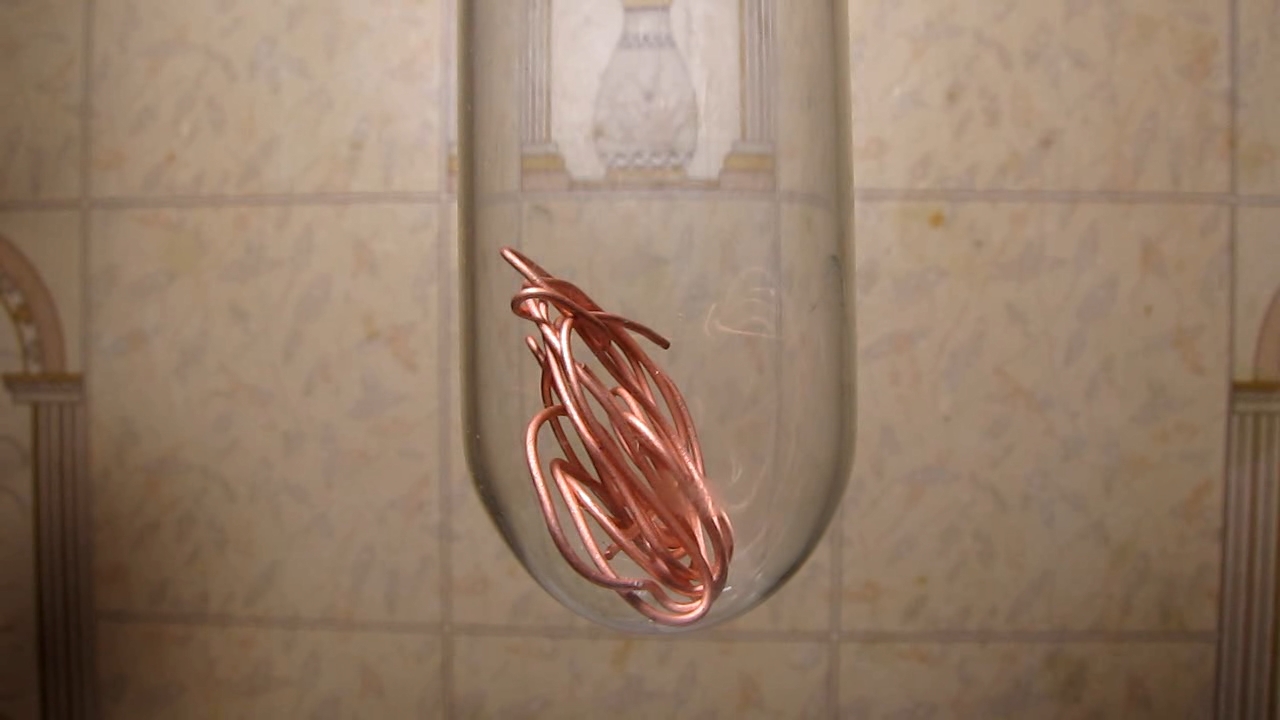
Hydrochloric acid dissolves copper metal |
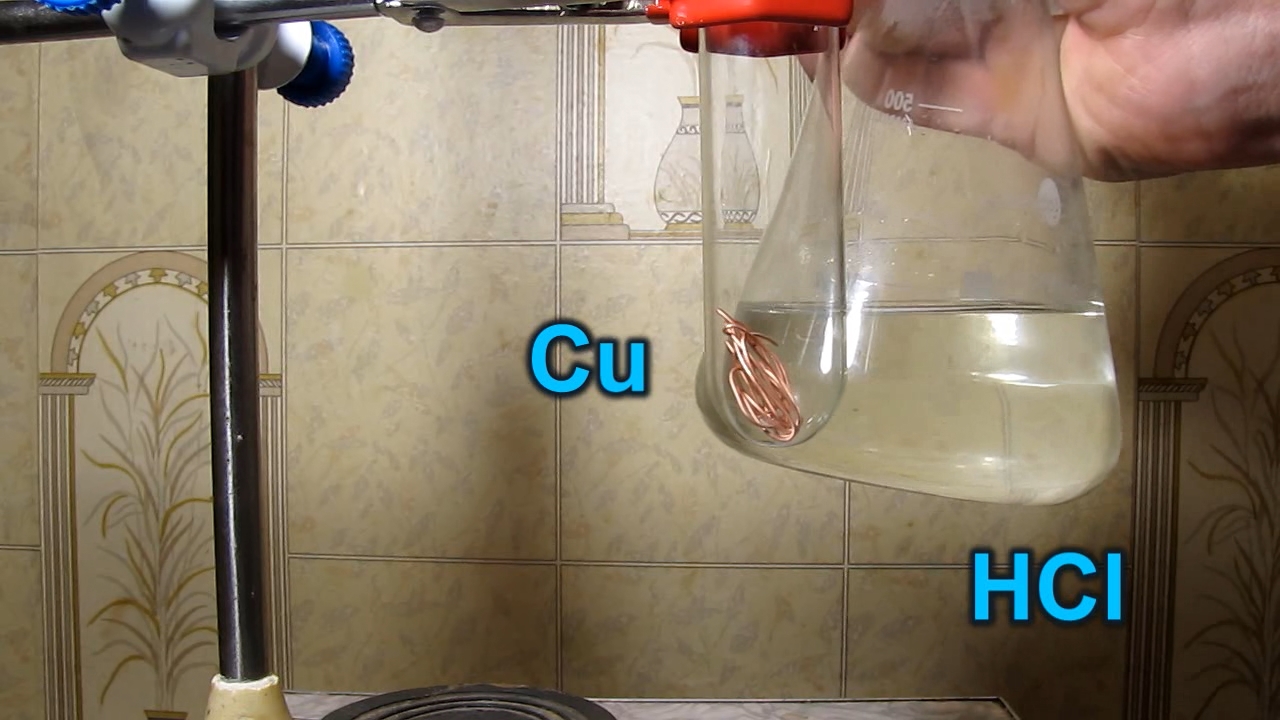
|
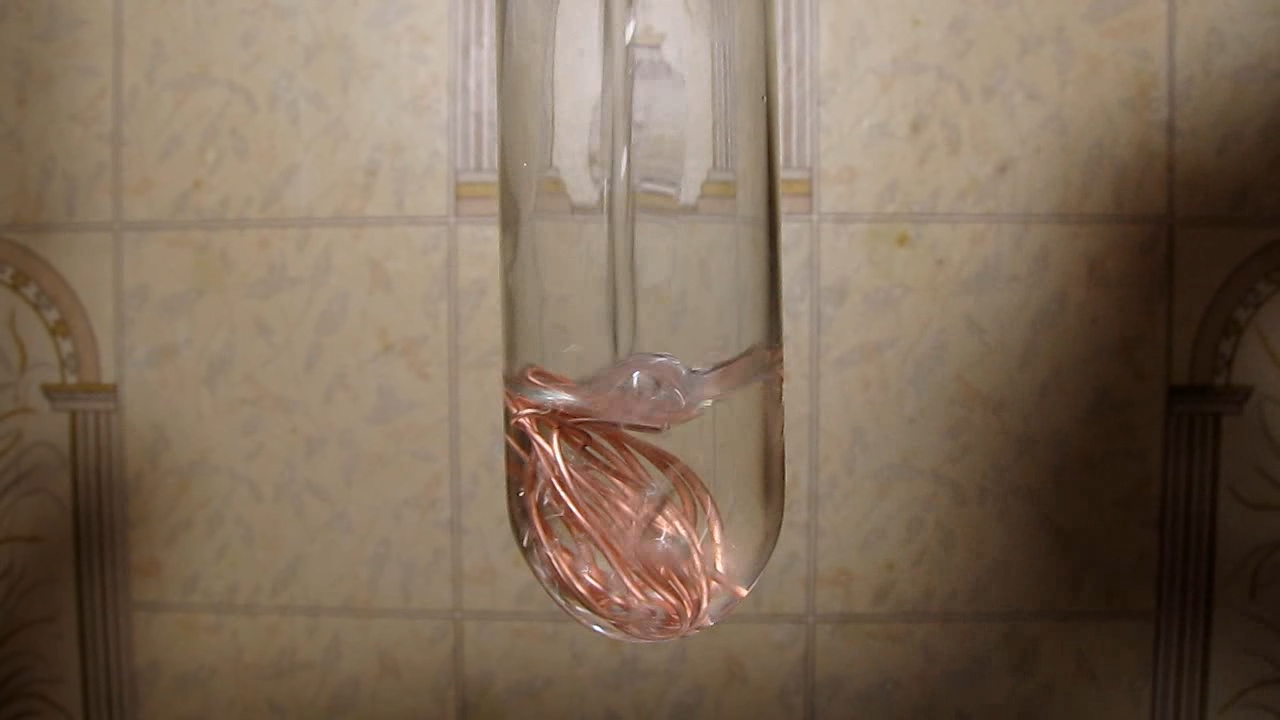
|
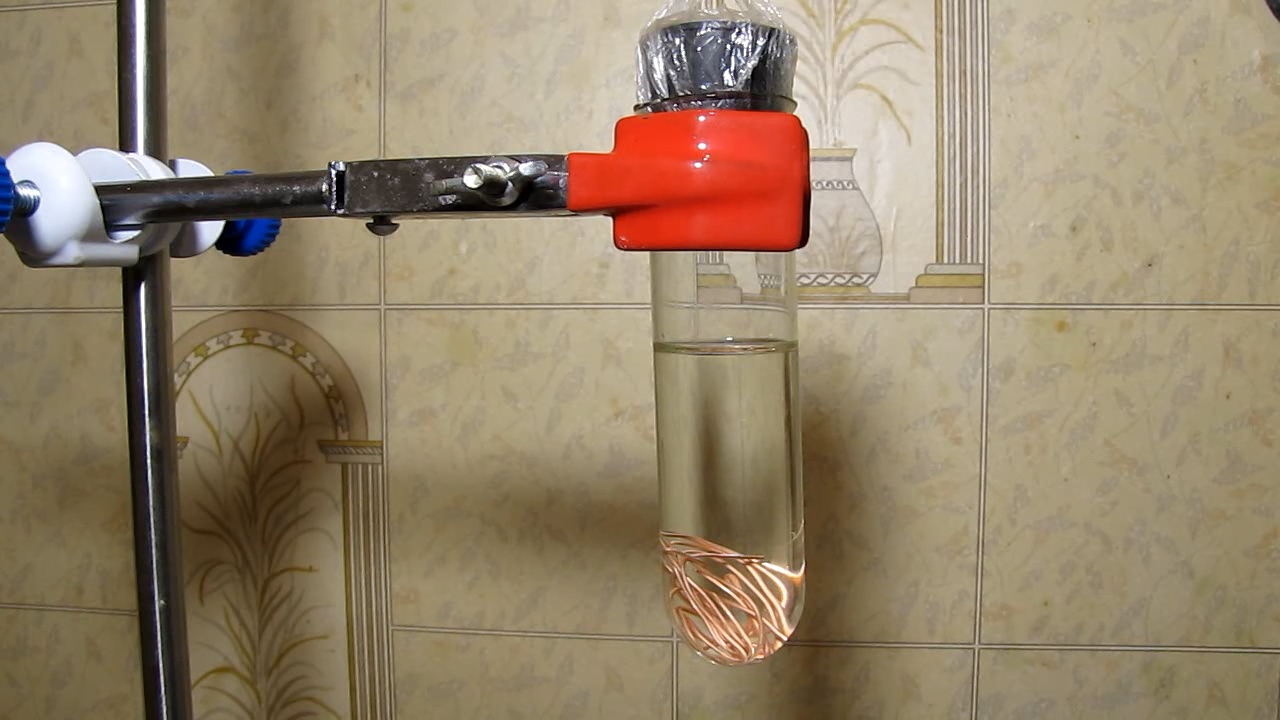
|
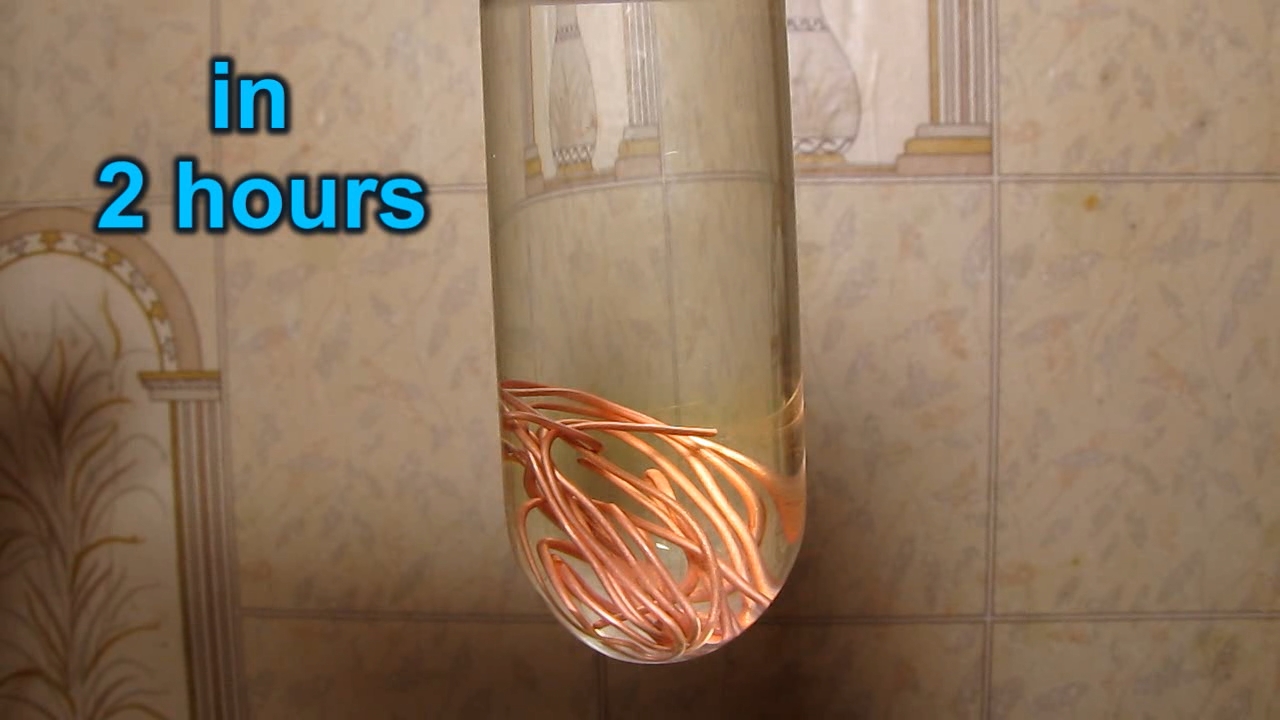
|

|
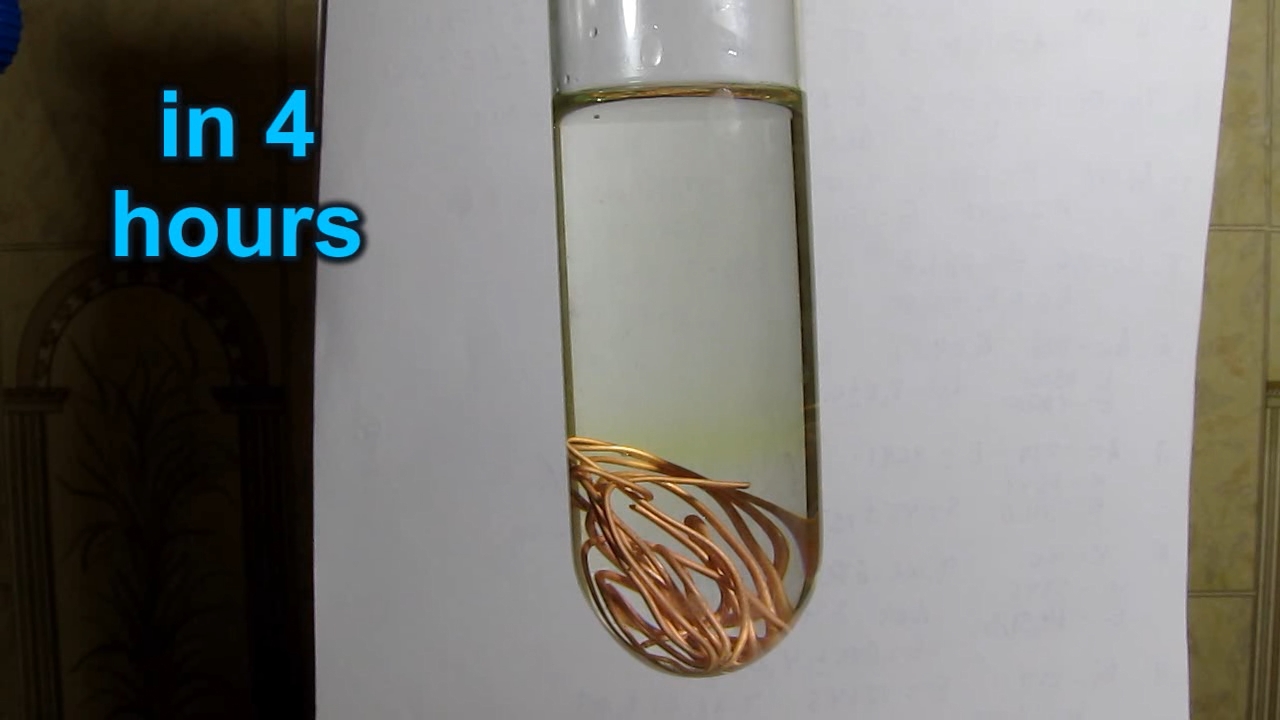
|
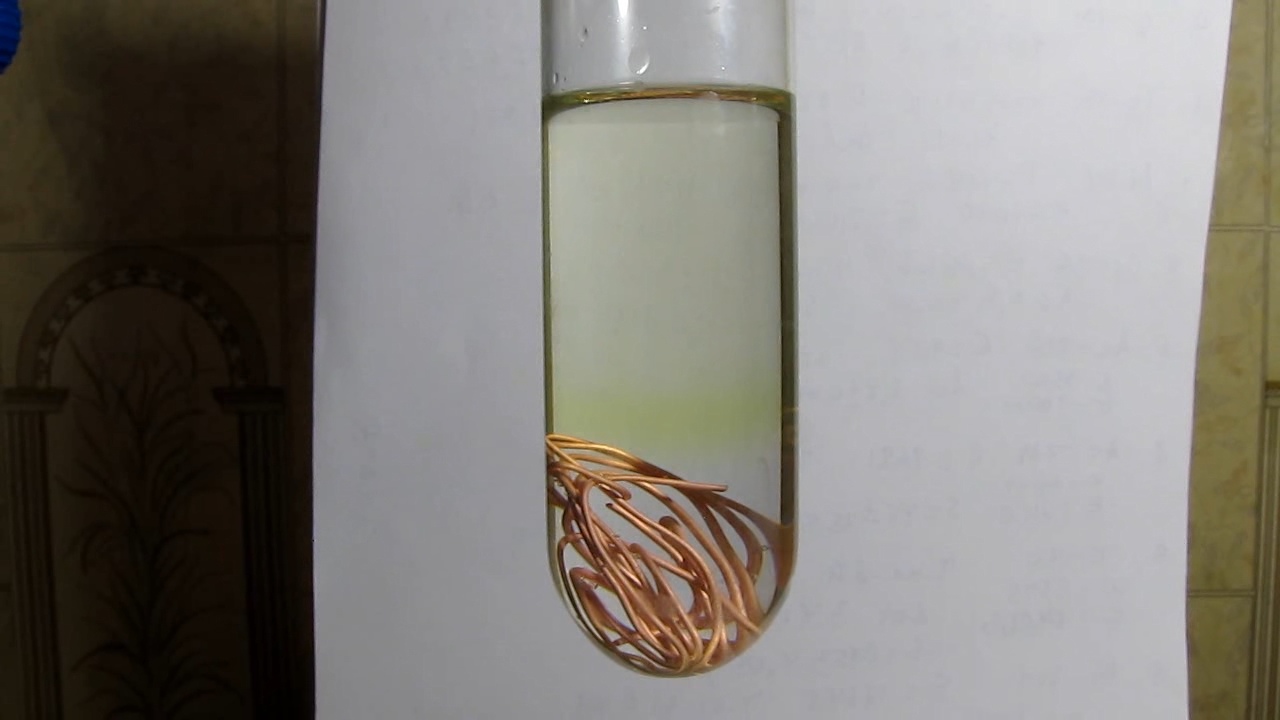
|
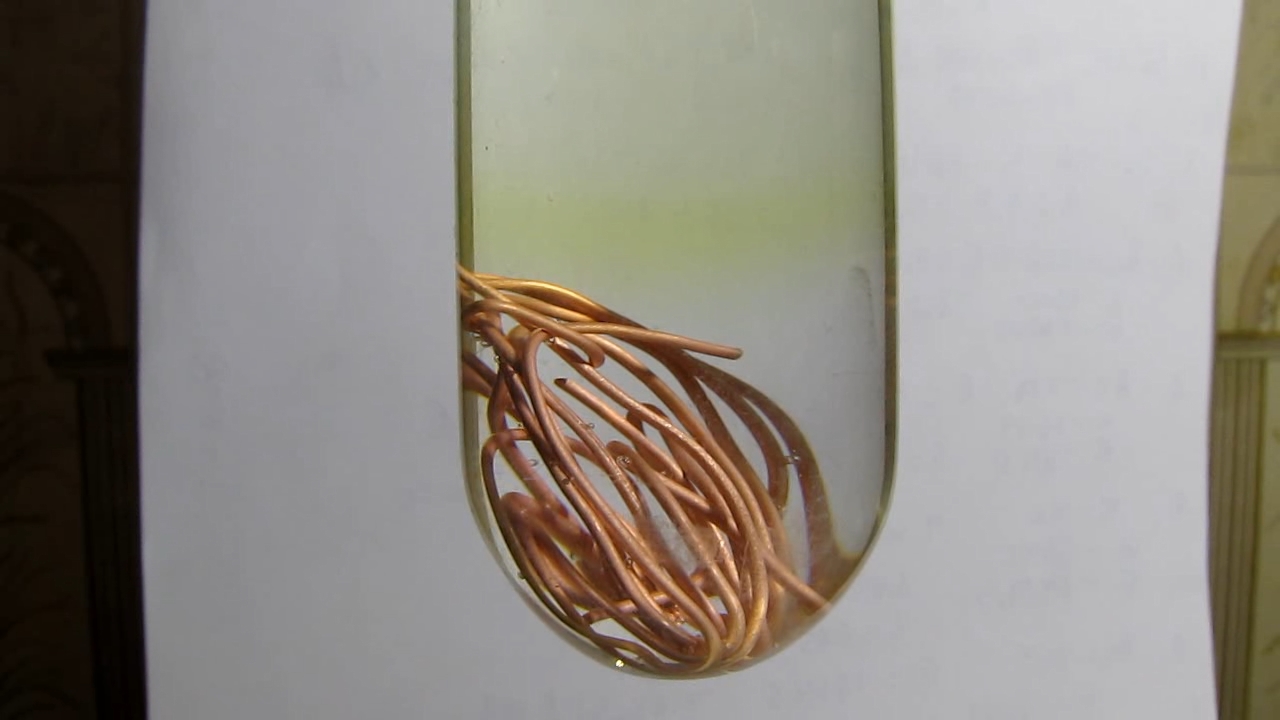
|

|
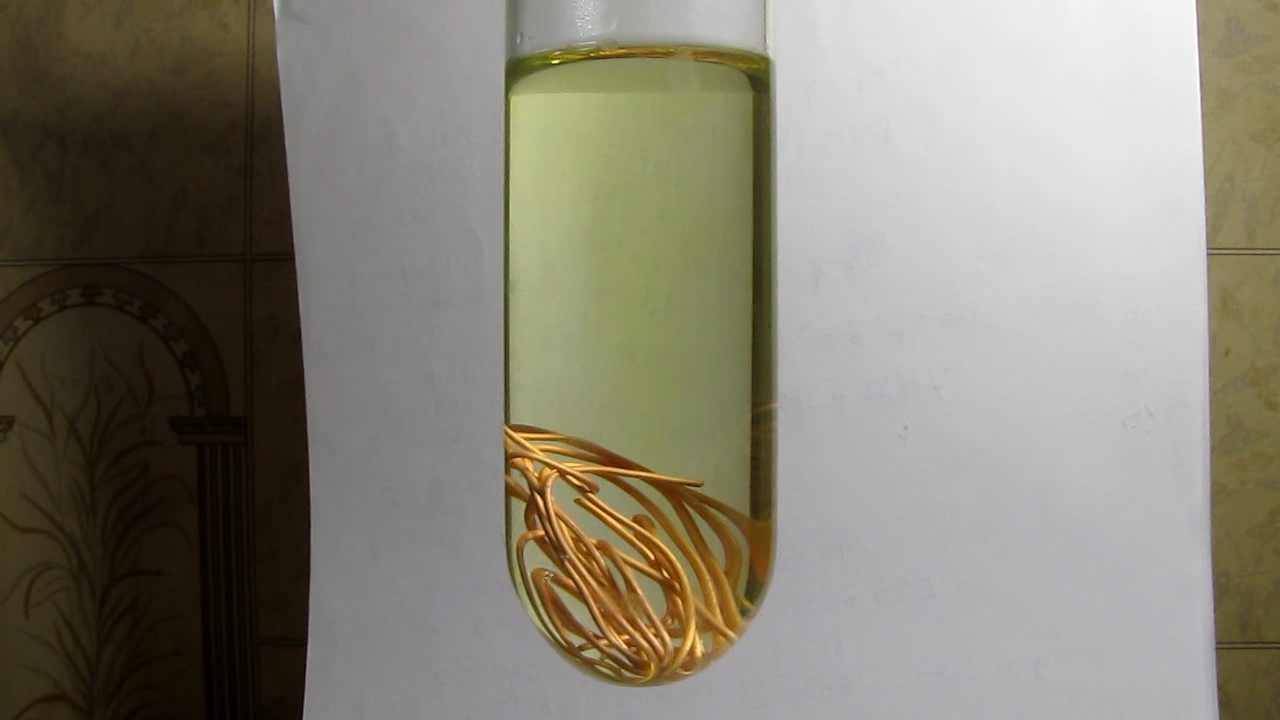
|
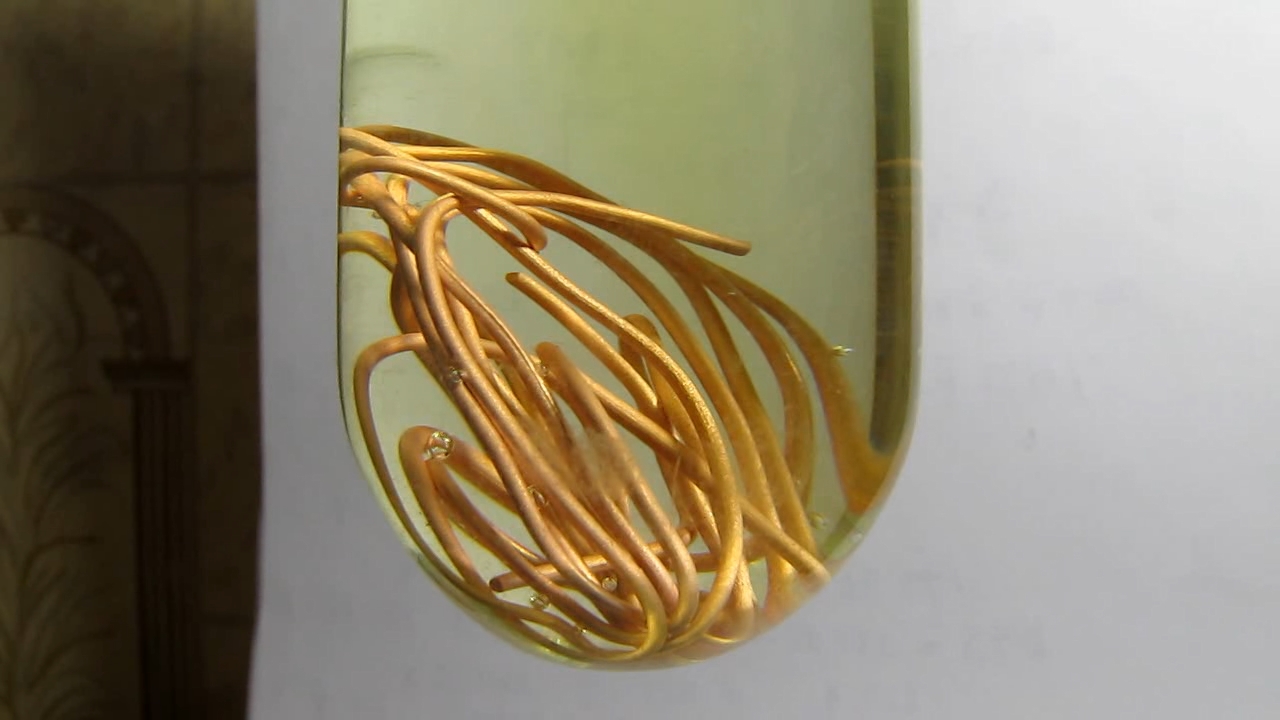
|
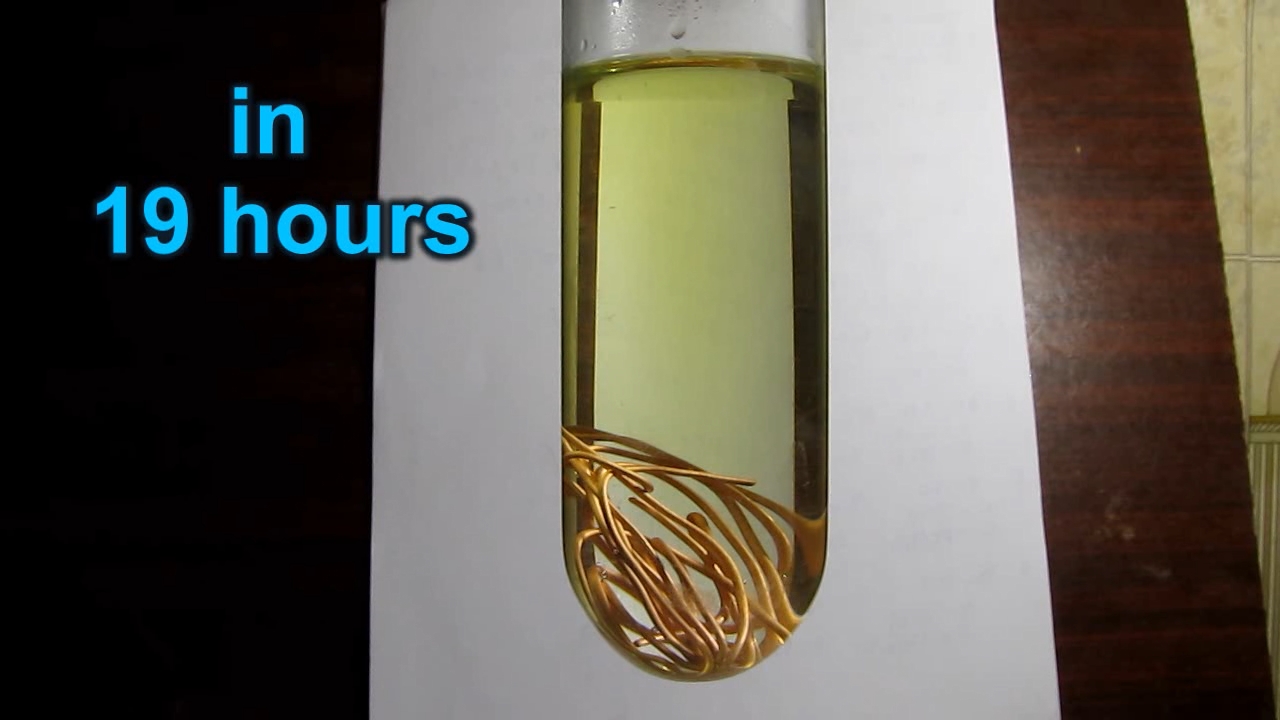
|
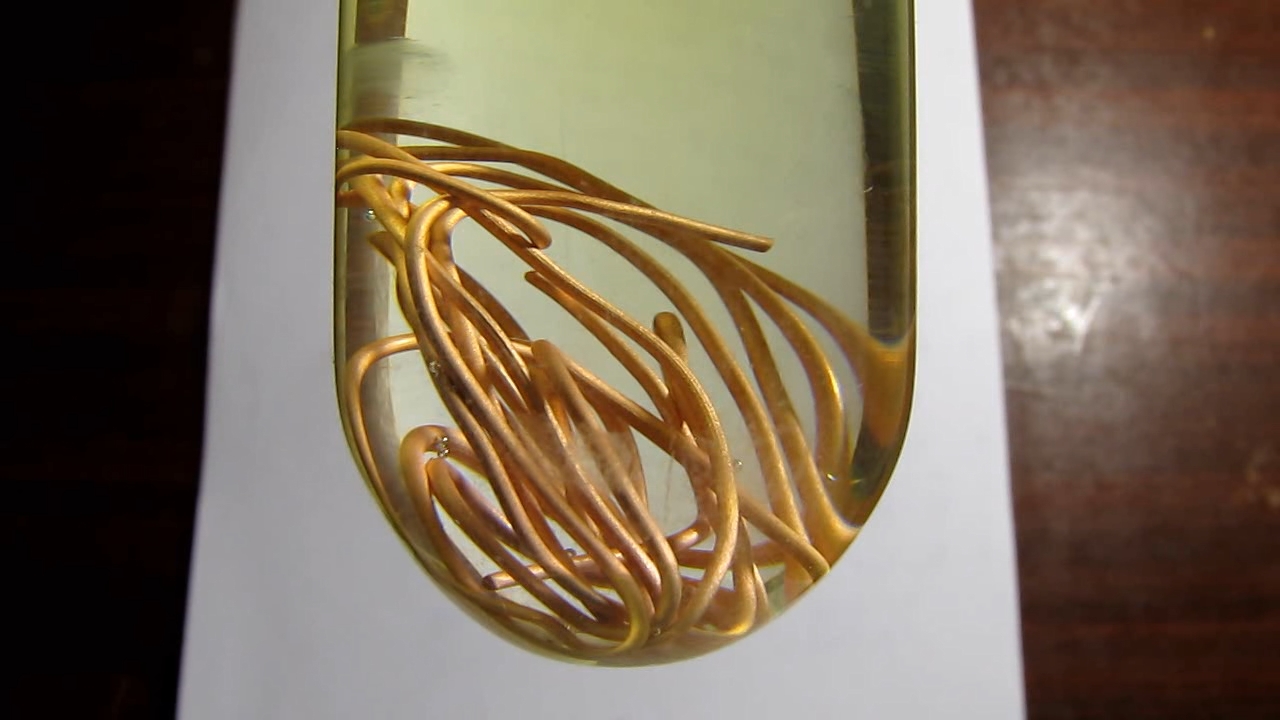
|

|

|
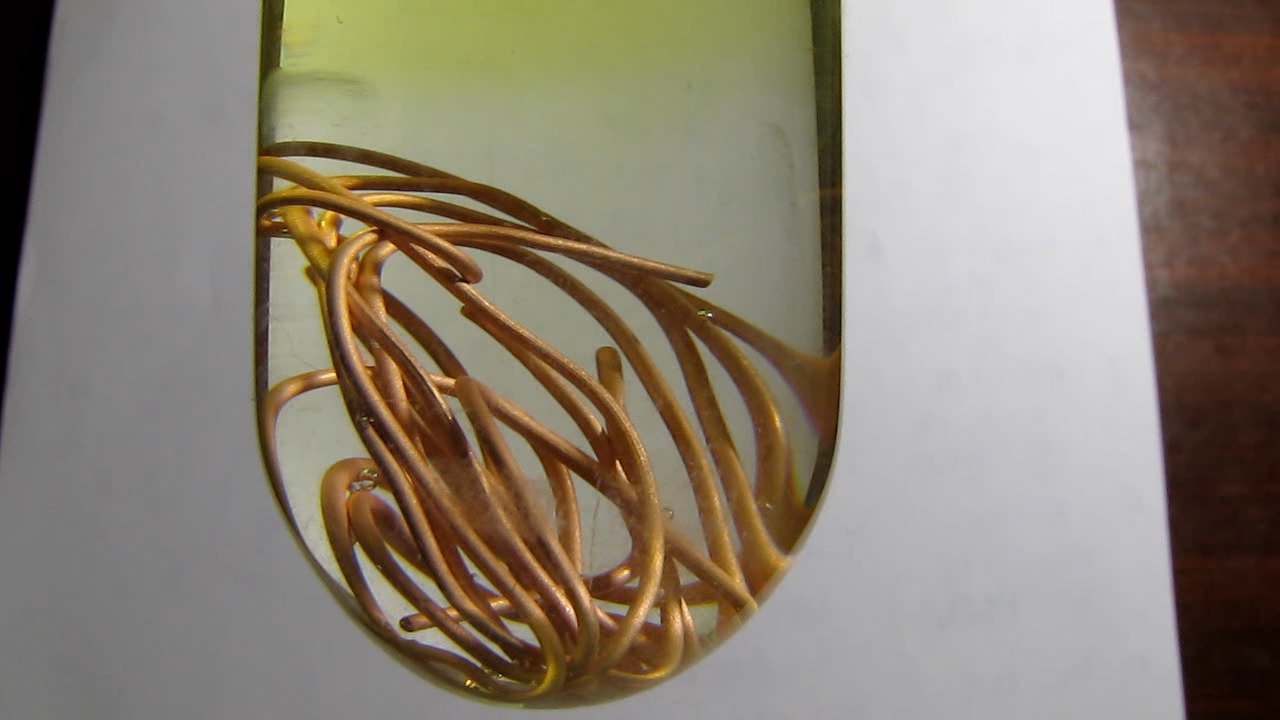
|

|

|

|

|
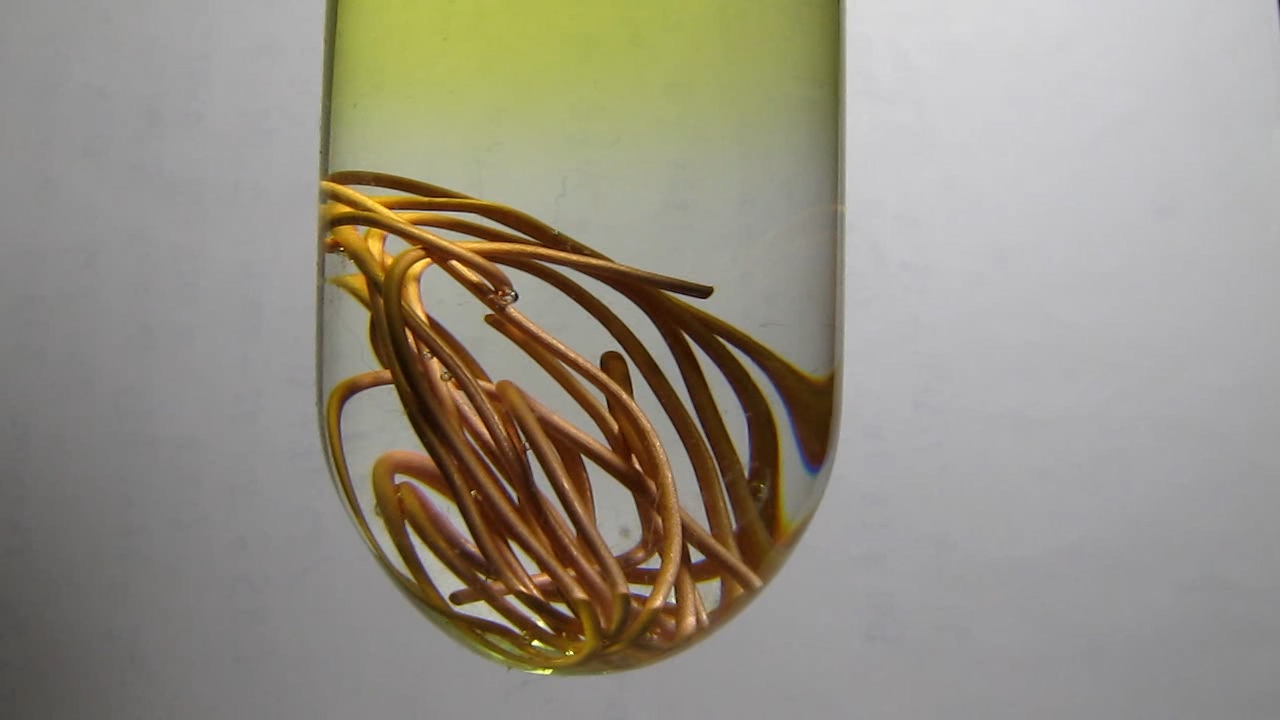
|
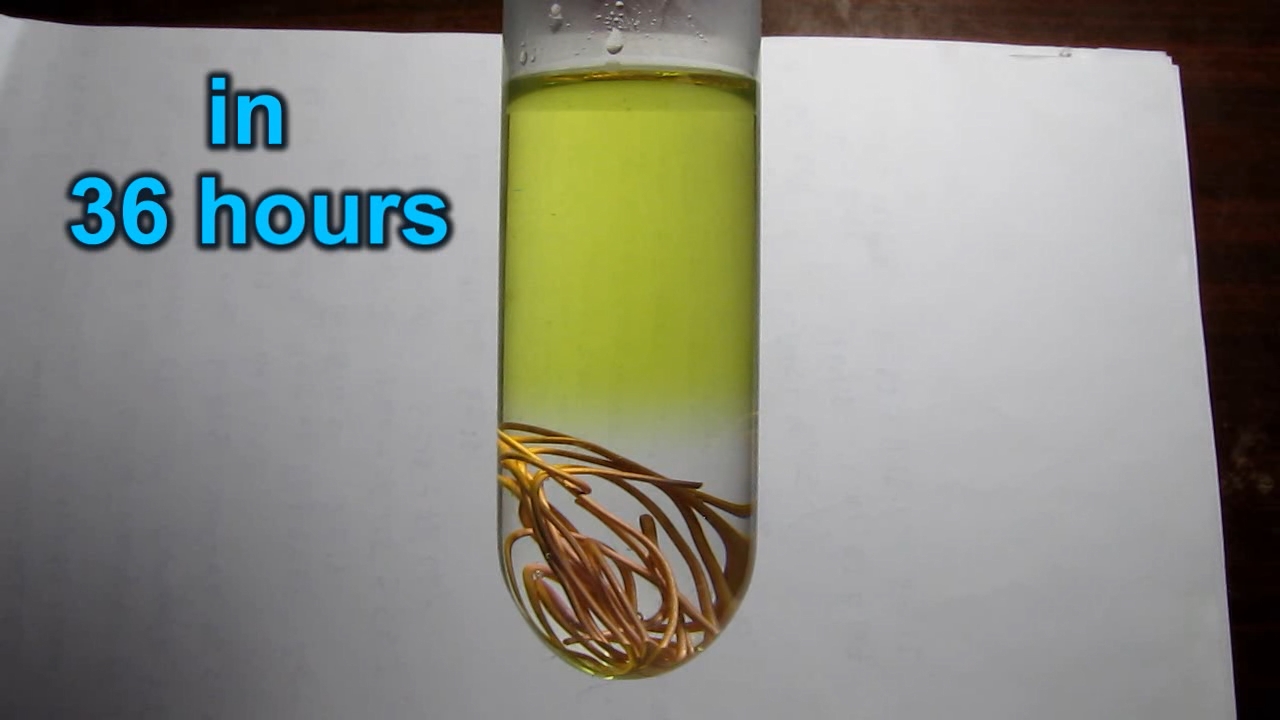
|
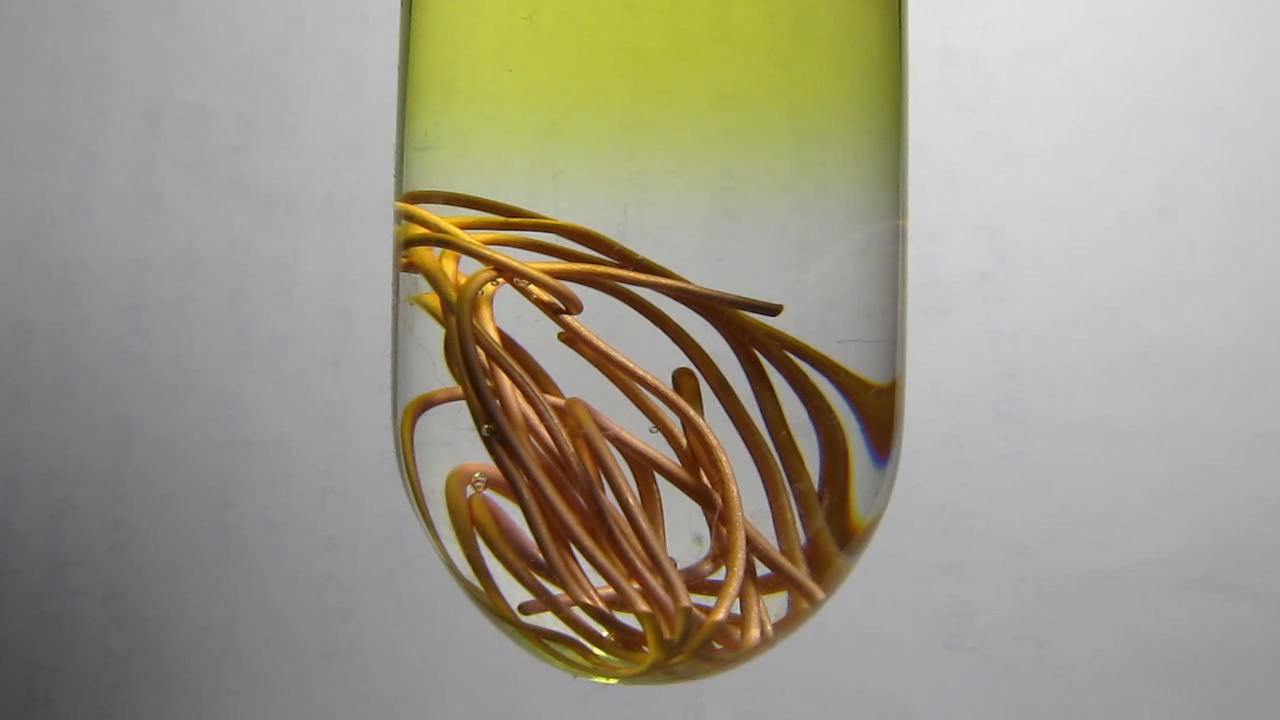
|

|
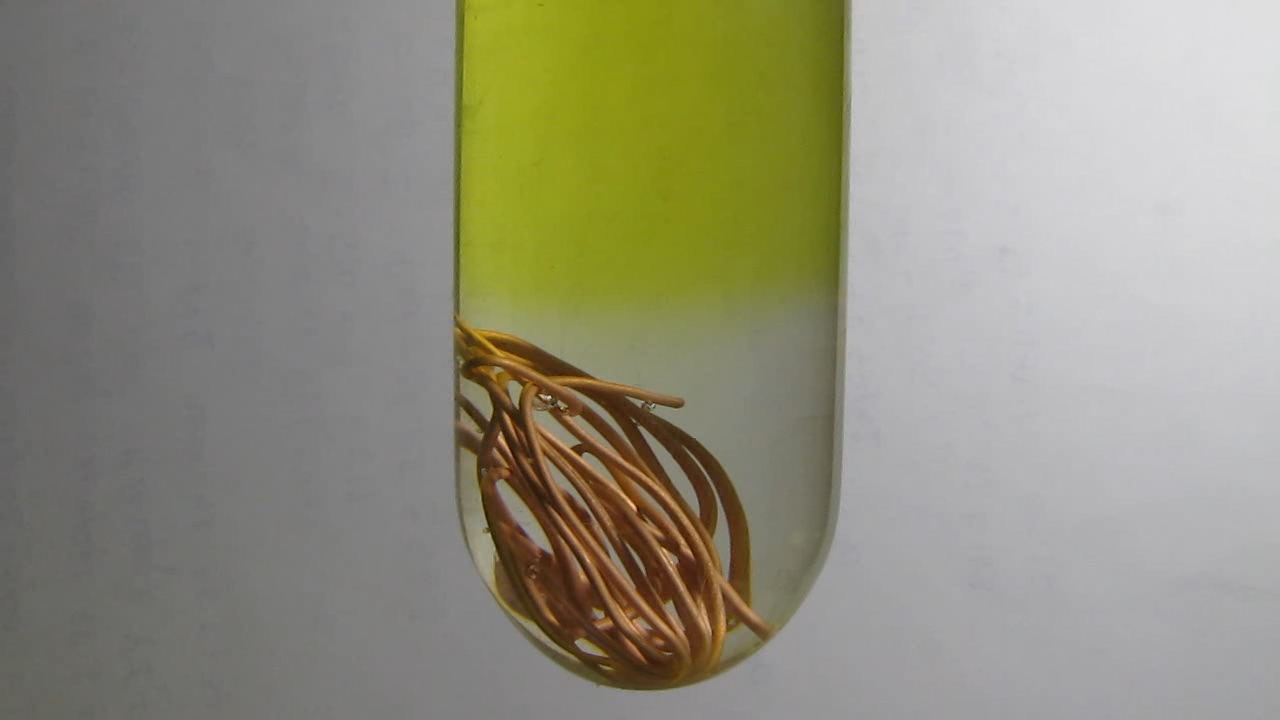
|

|
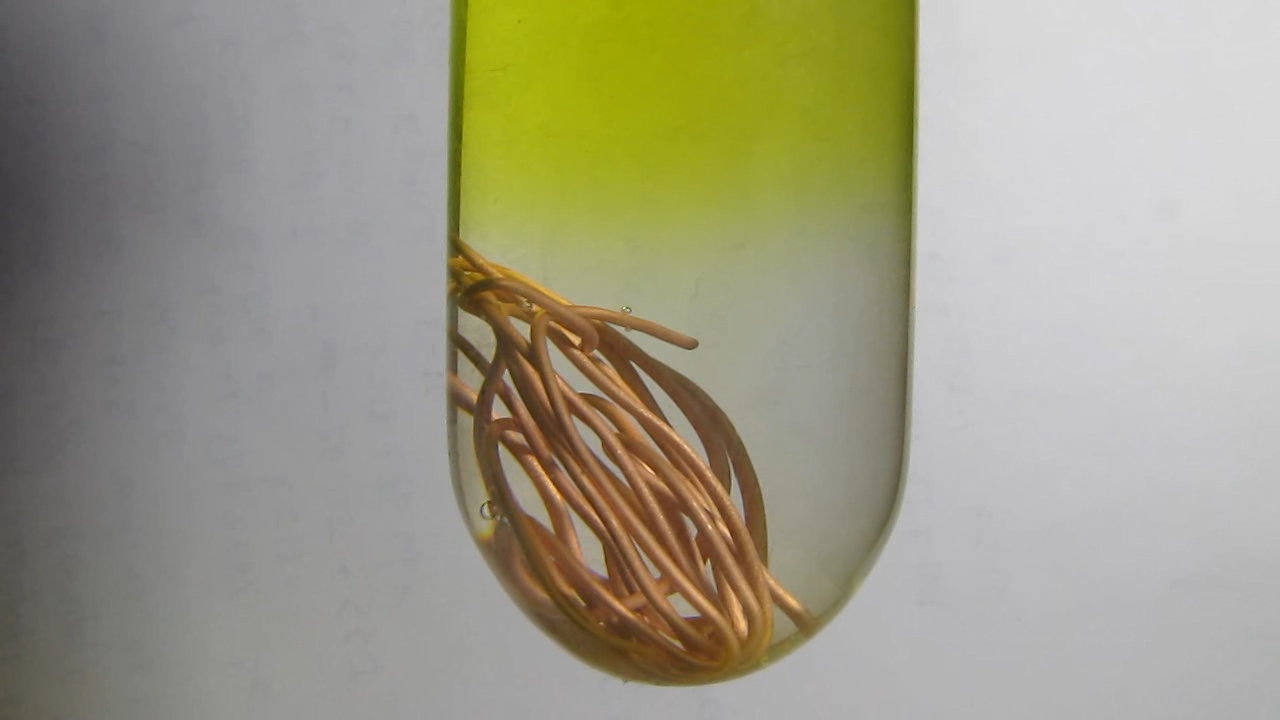
|

|

|
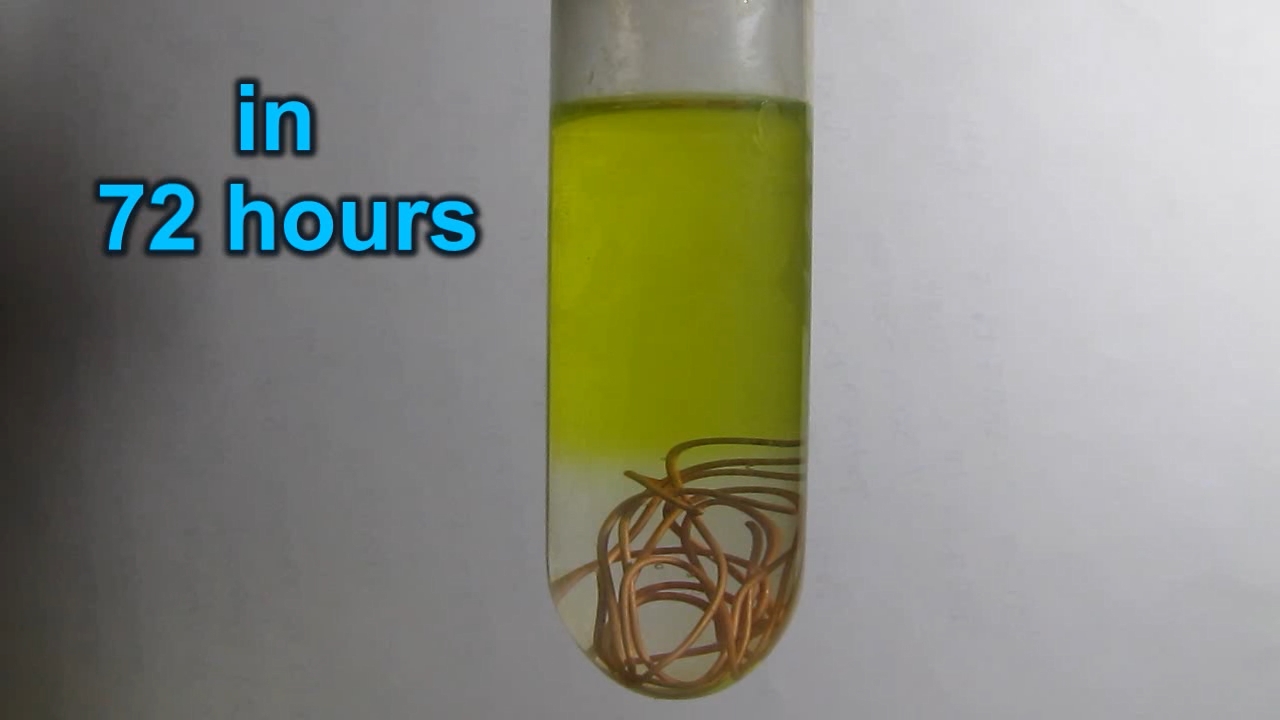
|
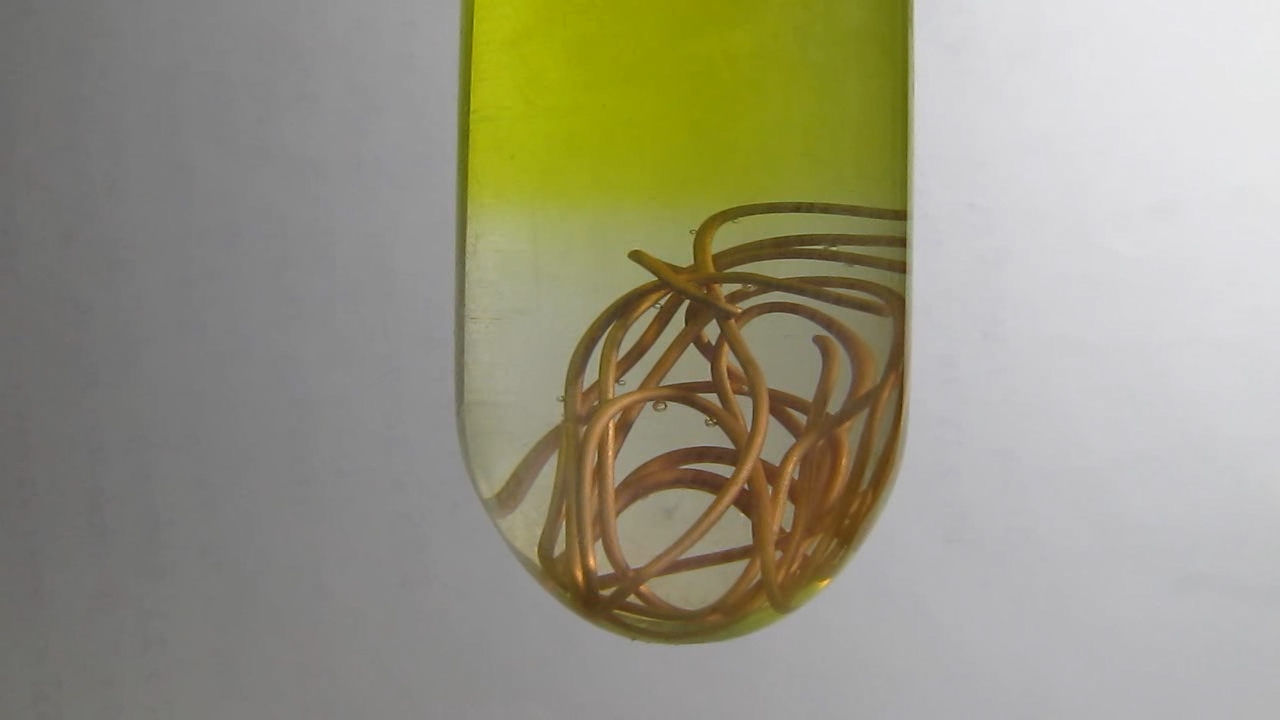
|
|
Having noticed a mistake in the text, allocate it and press Ctrl-Enter
Concentrated hydrochloric acid, air and copper metal - part 2
Let us summarize the results of the experiment described above. For 72 hours, the reaction occurred between copper, concentrated hydrochloric acid and atmospheric oxygen. As a result of this process, two layers were formed in the test tube. On top was a greenish-yellow solution of the chloride complex of divalent copper H2[CuCl4]. A colourless solution of the monovalent copper complex H[CuCl2] formed under it.
Концентрированная соляная кислота, воздух и металлическая медь - часть 2 Now we can continue the experiment. First, I decided to isolate the obtained solution (with metallic copper at the bottom) from the air, for example, using a layer of lighter organic liquid. My prediction: the cupric complex H2[CuCl4] will completely react with metallic copper to form a similar cuprous complex, leading to a complete discolouration of the solution. But later, a better idea emerged. As mentioned, I had done the reaction between copper and concentrated hydrochloric acid 15 years ago. The result was similar - two solution layers formed in the vessel, but there were also differences. During that long-ago experiment, the solution turned dark brown at the top of the vessel, however, in a recent experiment, the top layer turned greenish-yellow (i.e., the colour intensity was lower). The less intense colour indicates a lower concentration of copper in the solution; the obvious reason is poorer oxygen availability. In the experiment conducted 15 years ago, the contact surface between hydrochloric acid and air was larger, and the solution layer above the copper was thinner. To speed up the dissolution of metallic copper in hydrochloric acid, it is necessary to increase the area of contact between the liquid and gaseous phases and reduce the thickness of the solution layer above the metal. To do this, I poured the solution from the test tube into a 300 ml flask with a wide bottom and moved the copper wire into the flask. The flask was tightly capped, but there was enough air above the solution. The reaction vessel was shaken from time to time. After 14 hours, the solution in the flask was intensely greenish-yellow. There were no differences in the colour of the liquid depending on the height. After 20 hours, the solution turned dark yellow (brown) with a green tint. The colouring was uniform in height. A more intense colour indicates the transition of metallic copper into solution. Since the height of the acid layer was minimal, the two layers [copper (II) and copper (I)] were not formed in the reaction vessel this time. Thus, an increase in the contact surface of the solution and oxygen, as well as a decrease in the thickness of the liquid layer, led to the acceleration of the dissolution of copper metal in hydrochloric acid. The next step was to return the solution and copper wire to the same test tube and seal it again. While it was in the flask with the acid, the thickness of the copper wire visually decreased significantly (this was also noticeable "to the touch"). After 1 hour, the solution near the bottom of the test tube became noticeably lighter than at the top. After 5.5 hours, the solution at the bottom turned light yellow. The top layer remained dark, green-yellow. Between these two layers, there was an intermediate "diffuse" layer. After 12 hours, there were three layers in the test tube. Above is the dark, green-yellow layer, and below is the colourless layer. Between them, there was the intermediate diffuse layer. Thus, the intensely coloured layer again formed on top of the test tube, and the colourless layer was below. In the next step, I shook the test tube to mix the solution and poured a layer of hexane on top of the solution, which isolated the solution from the air. Then, I closed the test tube tightly (otherwise the hexane would quickly evaporate). After 2 hours, the lower part of the solution became lighter. After 3 hours, the two layers (and the intermediate diffuse layer between them) were again formed in the test tube. After this, I expected that the entire solution in the test tube would gradually become discoloured since the access of oxygen to the solution ceased. As a result, all the divalent copper in the solution would react with metallic copper and be consumed, forming the colourless copper(I) complex. In reality, the result of the experiment was different. ... 22 hours, 30 hours, 55 hours and even 5 days passed... However, all this time two layers remained in the test tube: the top layer was dark, green-yellow, the bottom layer was colourless, and between them, there was the diffuse layer. As I write this, 7 days have passed since I poured the hexane layer into the test tube, but no further changes have yet been observed. I have no reasoned versions to explain this result of the experiment. Perhaps the readers can help? |

Concentrated hydrochloric acid, air and copper metal |

|
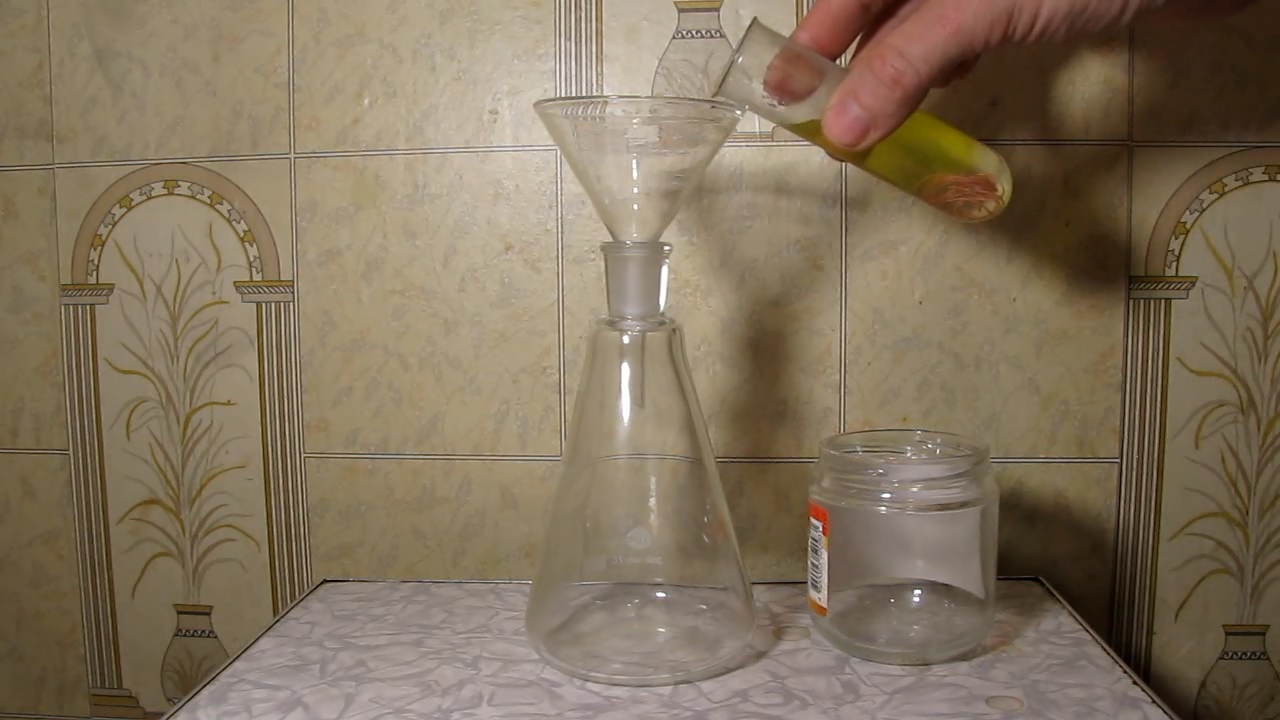
|
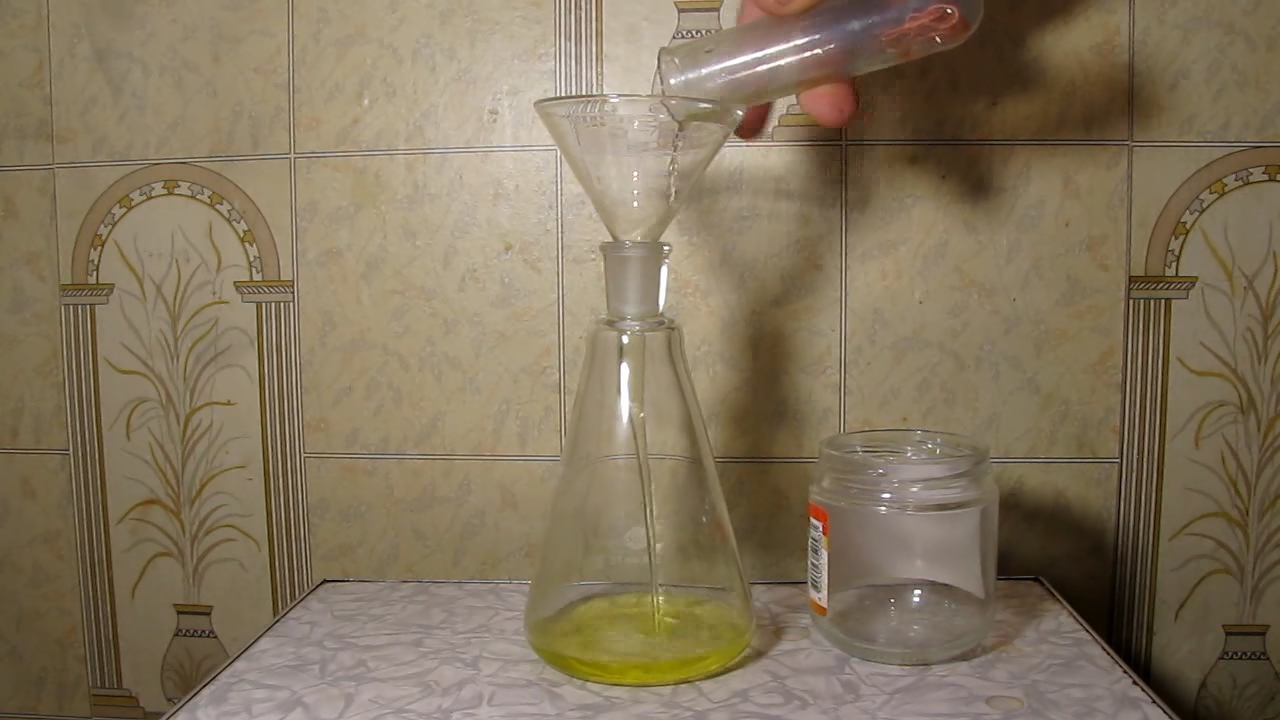
|
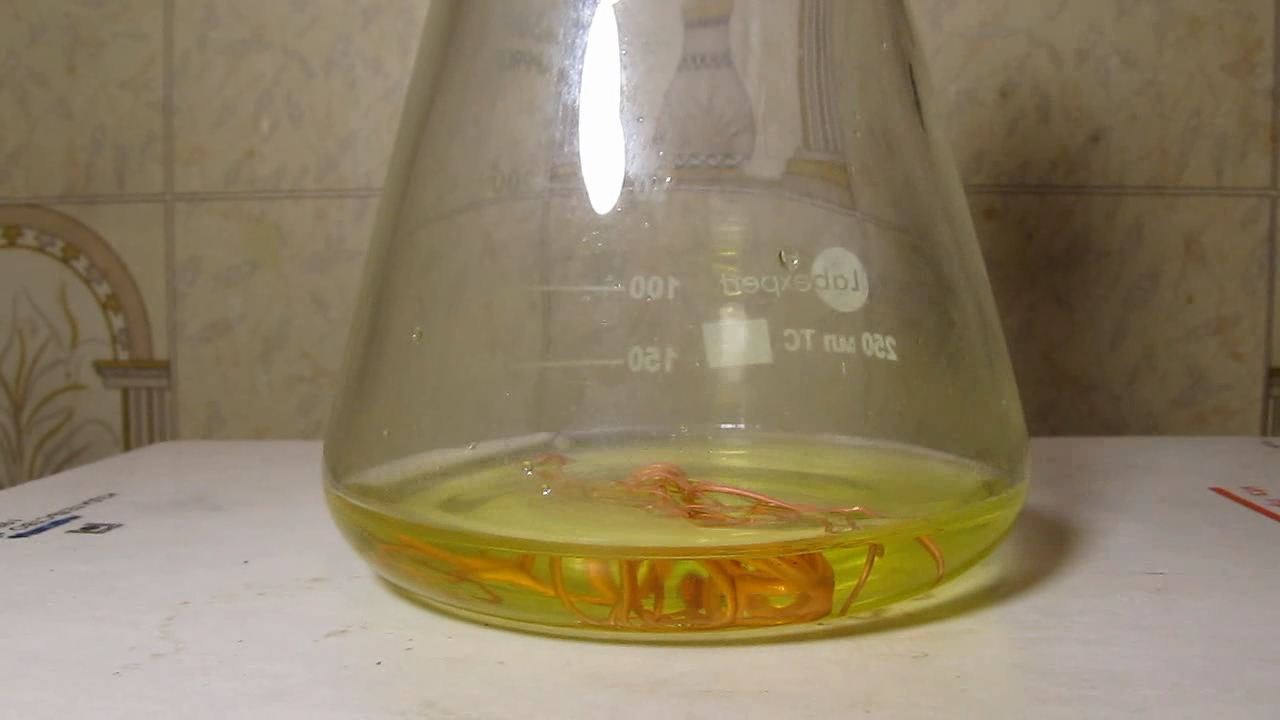
|
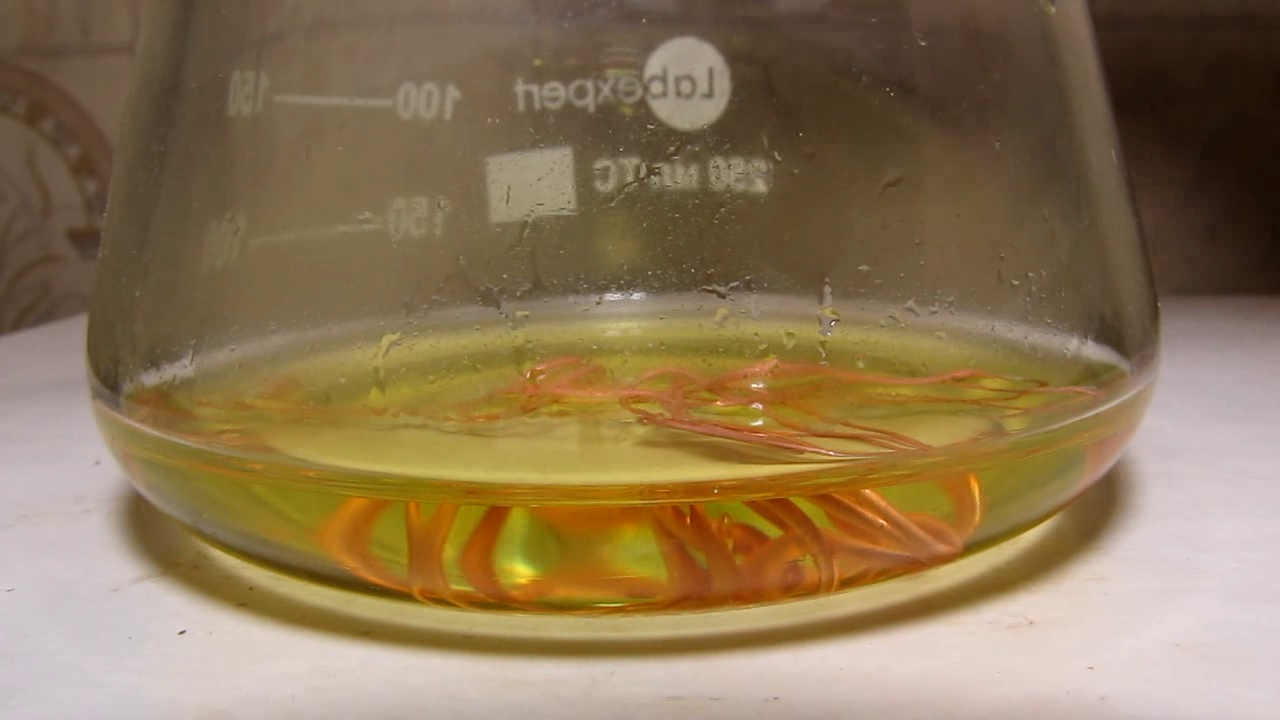
|
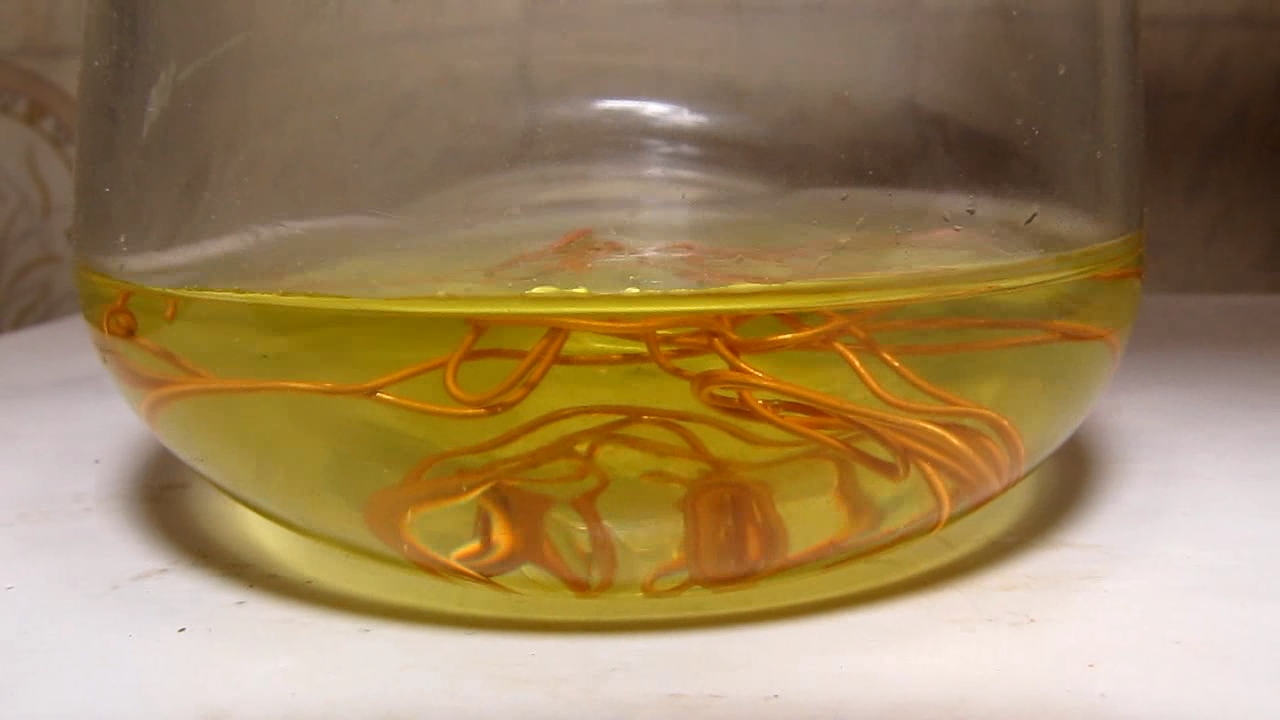
|

|
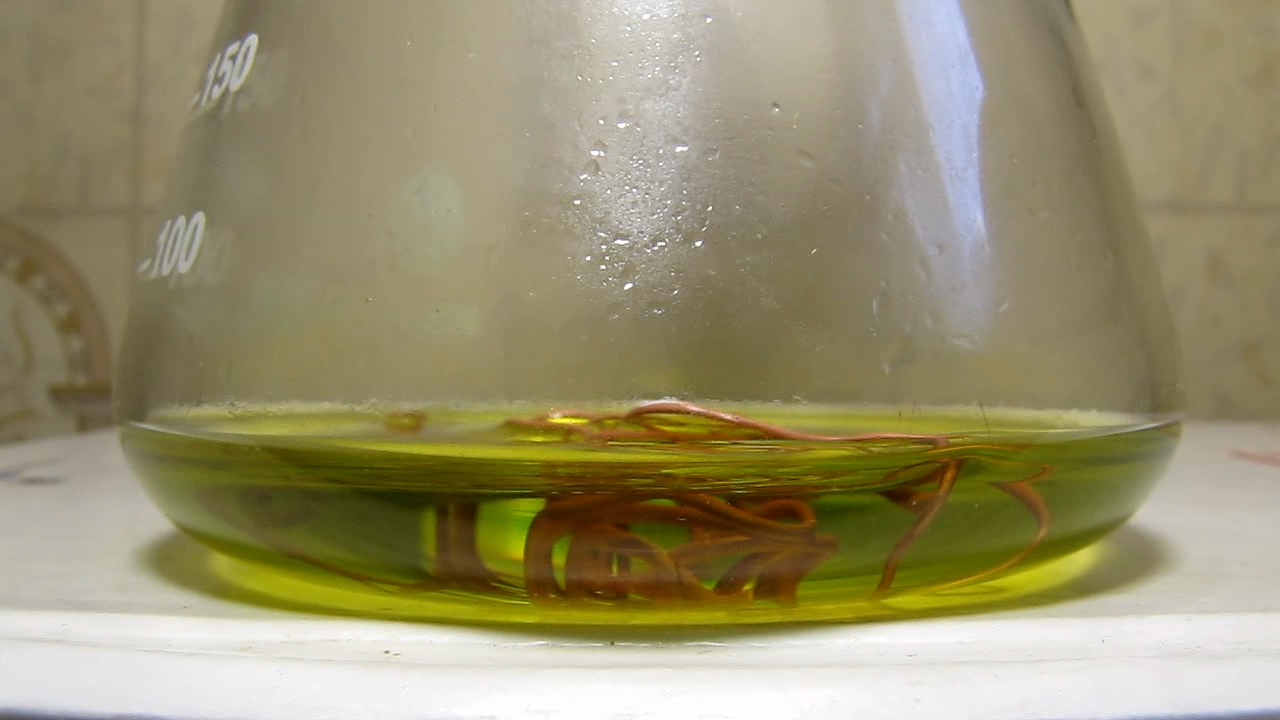
|

|

|
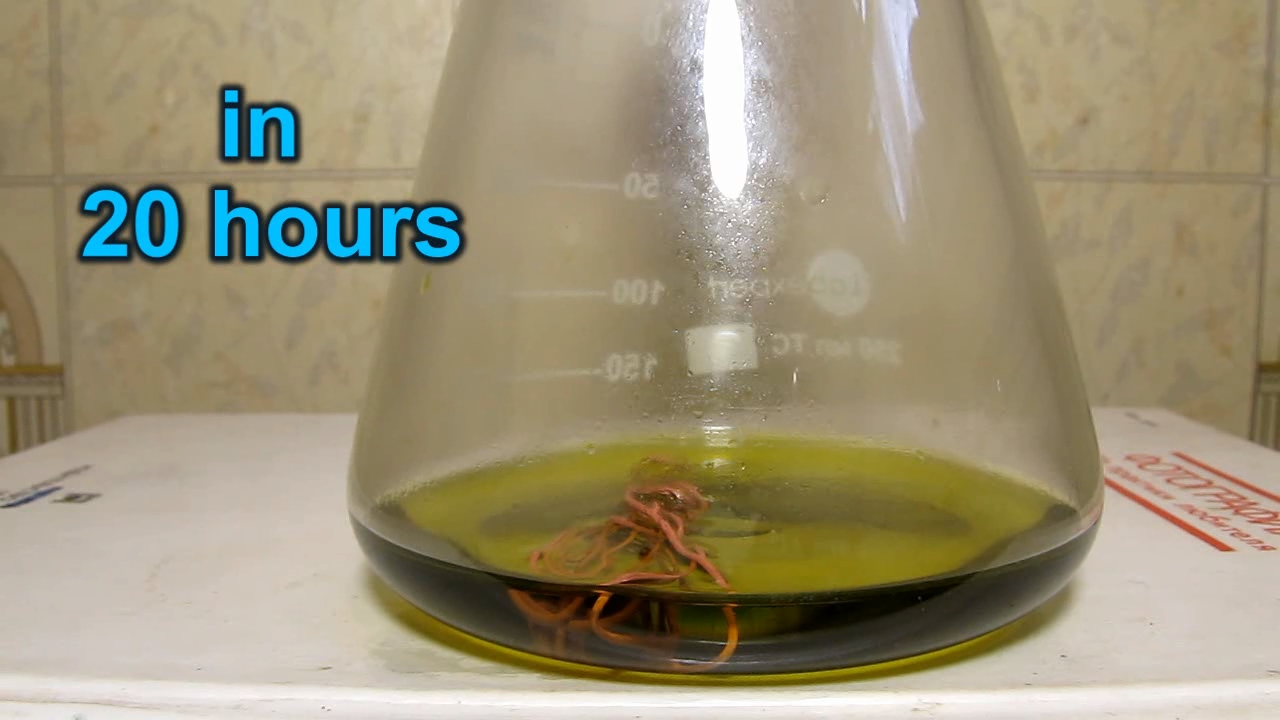
|
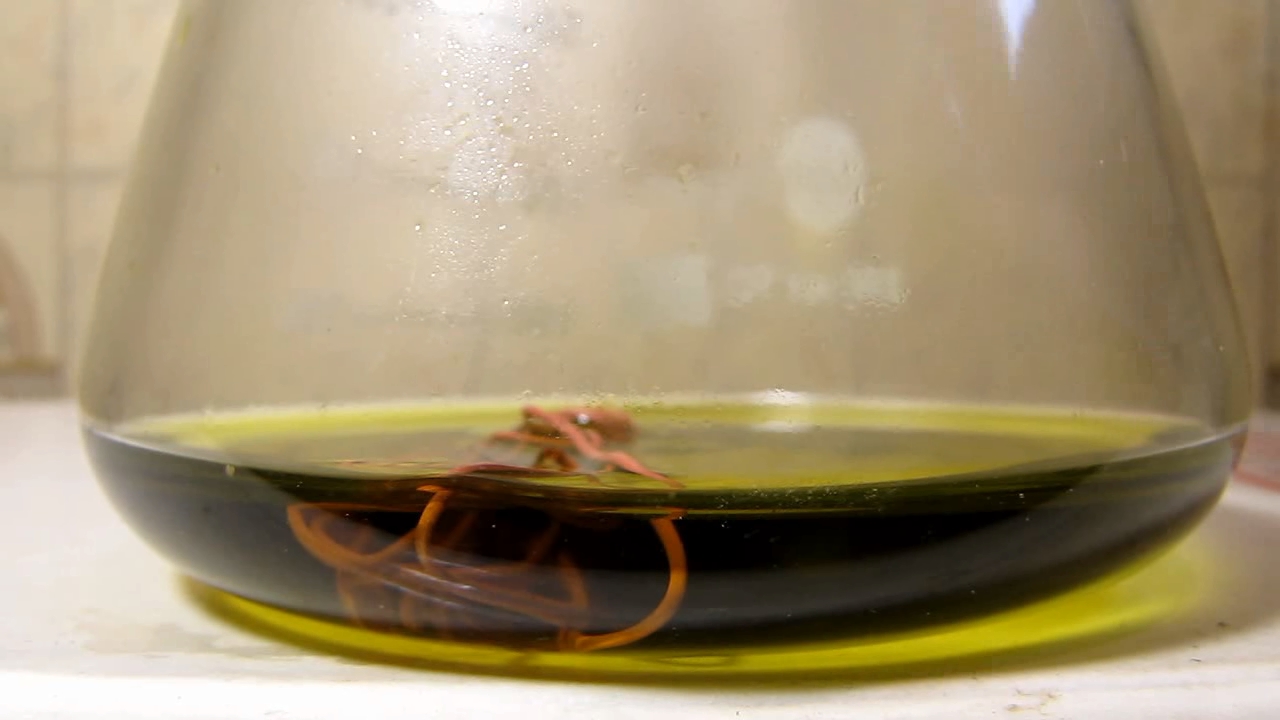
|
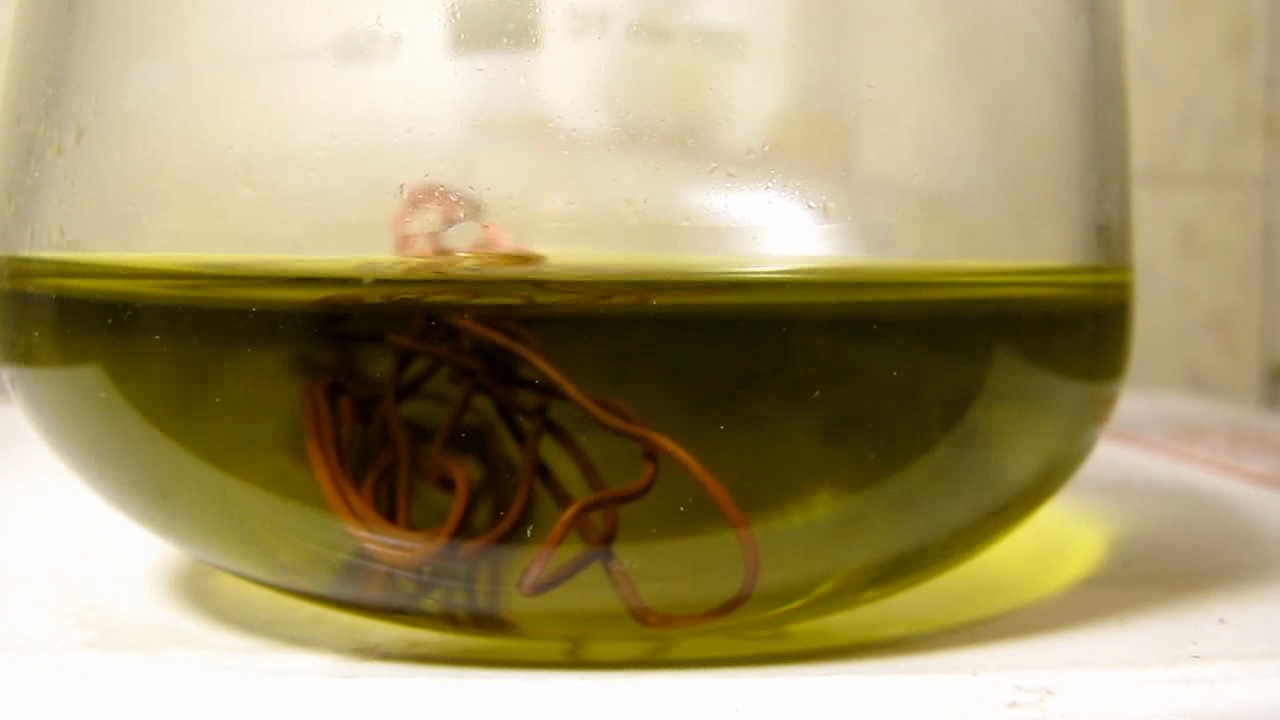
|

|

|

|
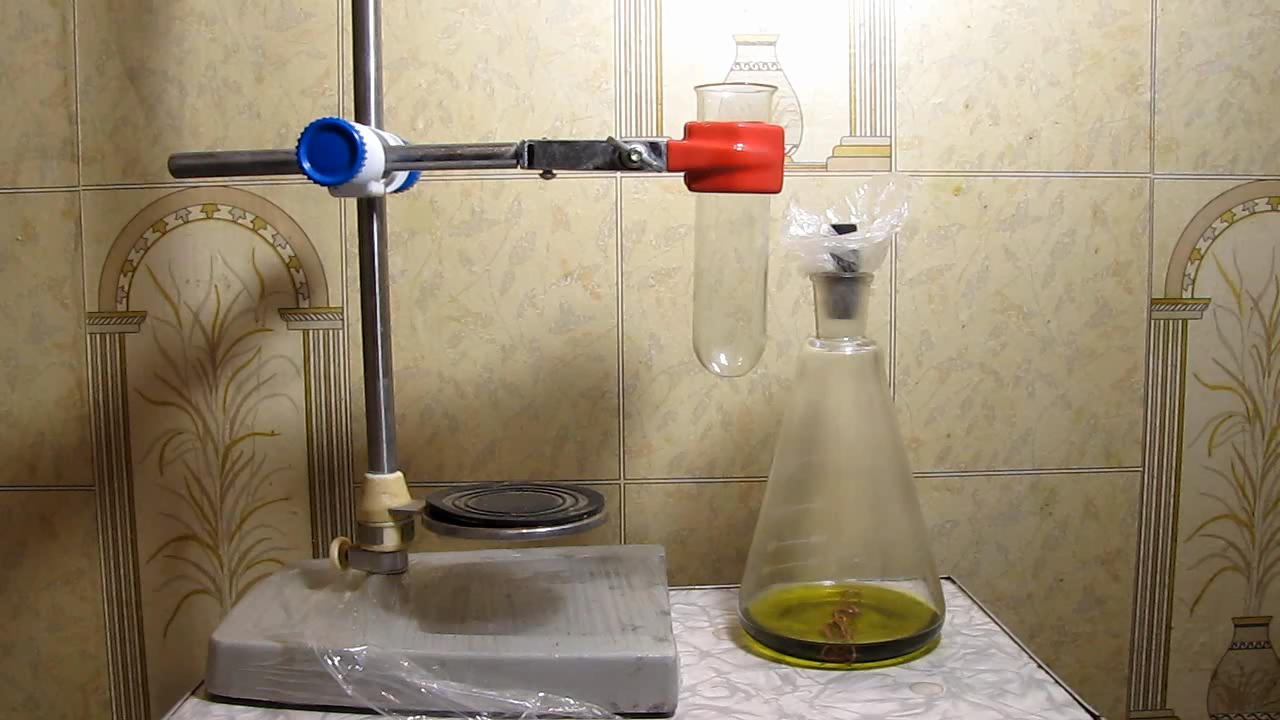
|
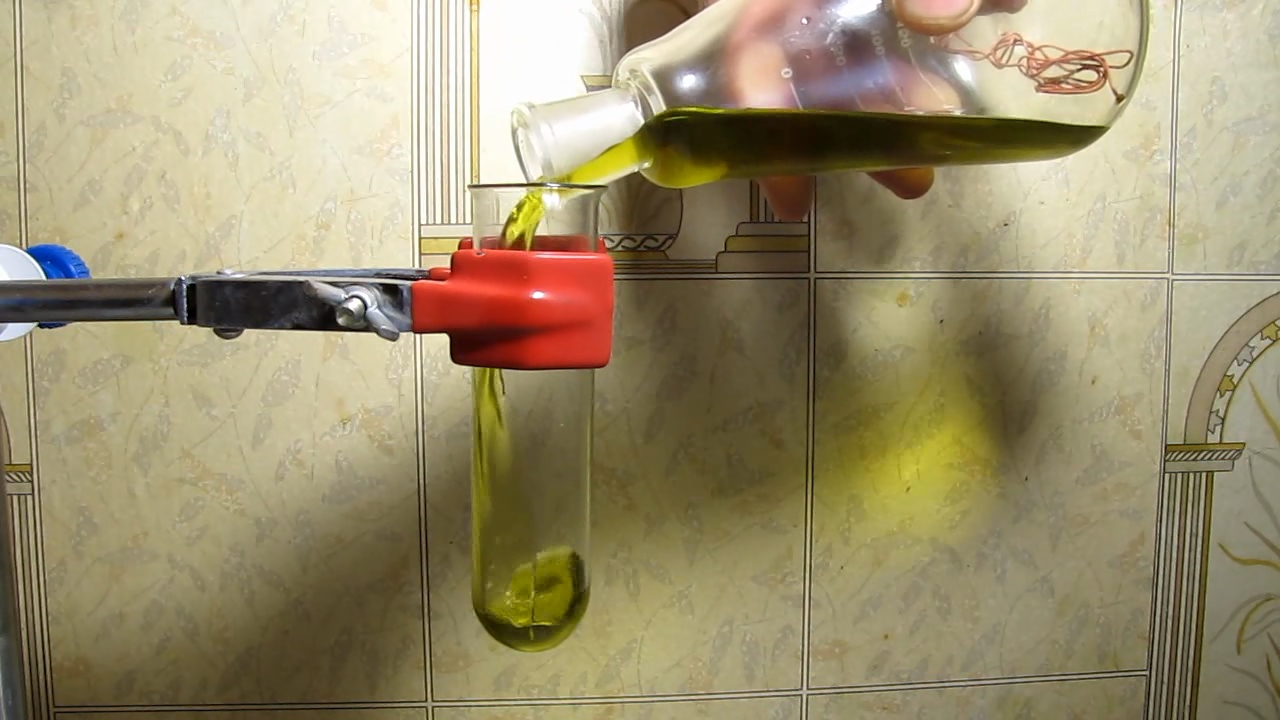
|
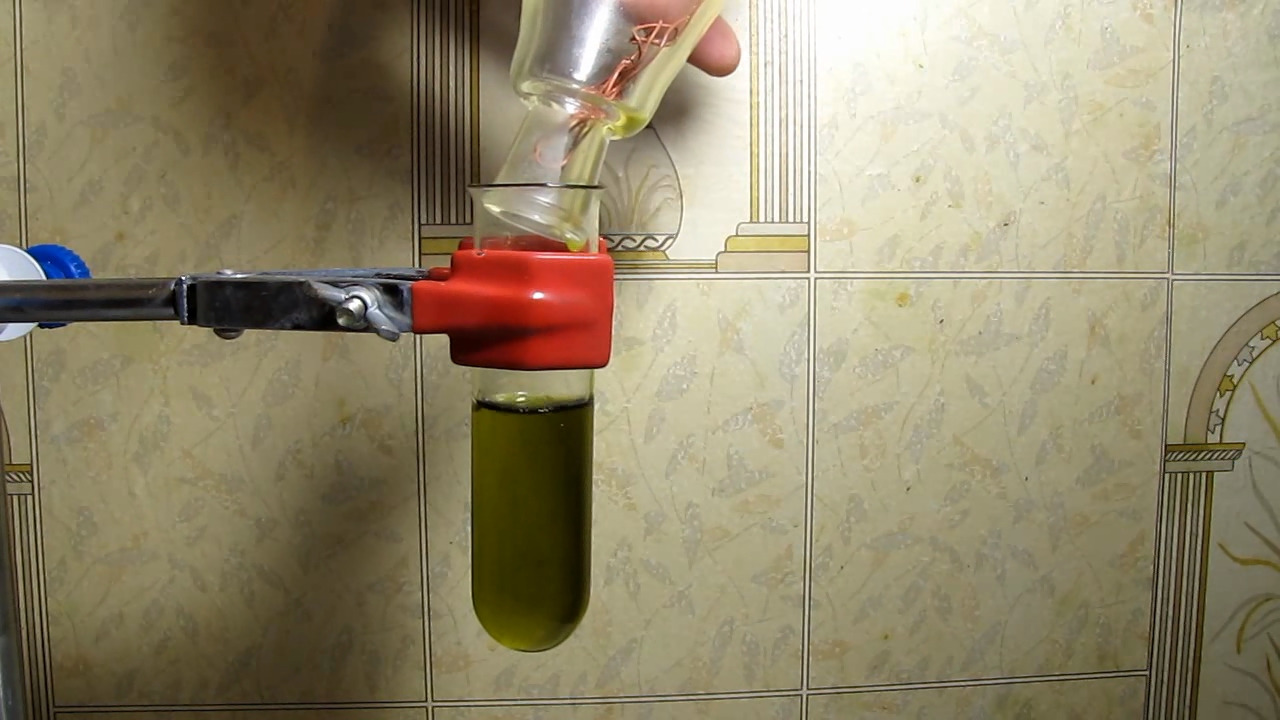
|
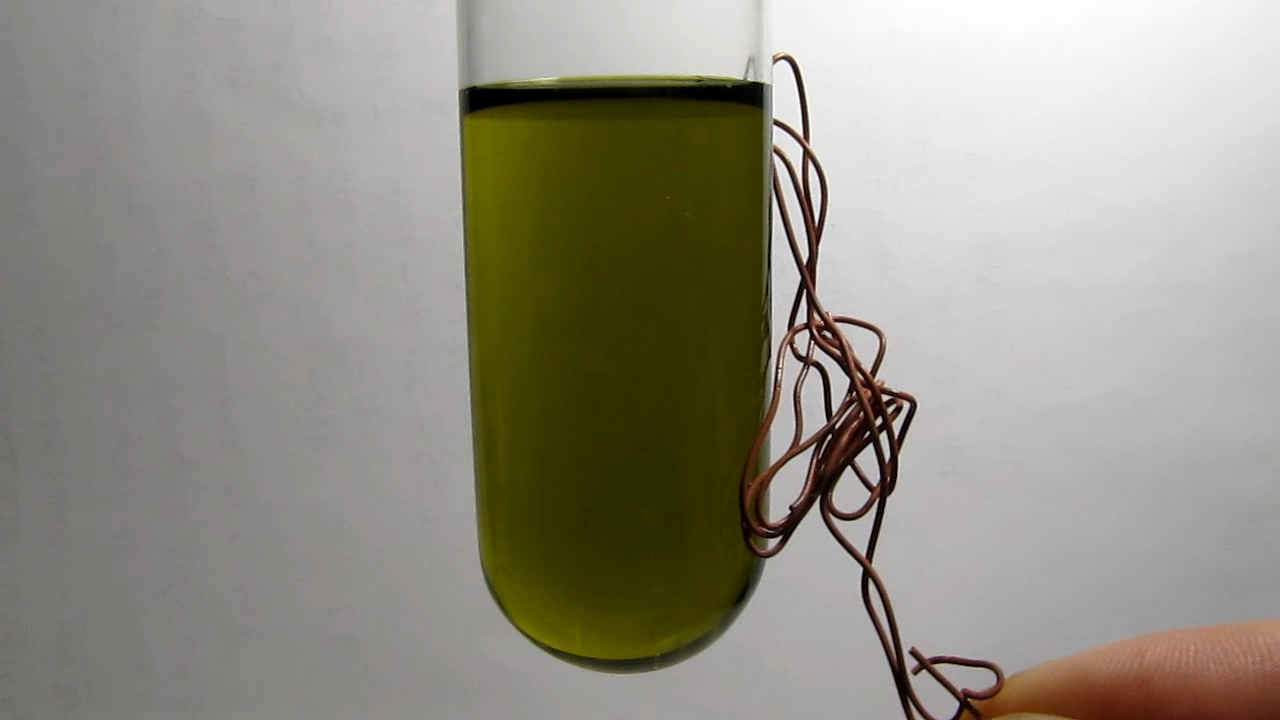
|
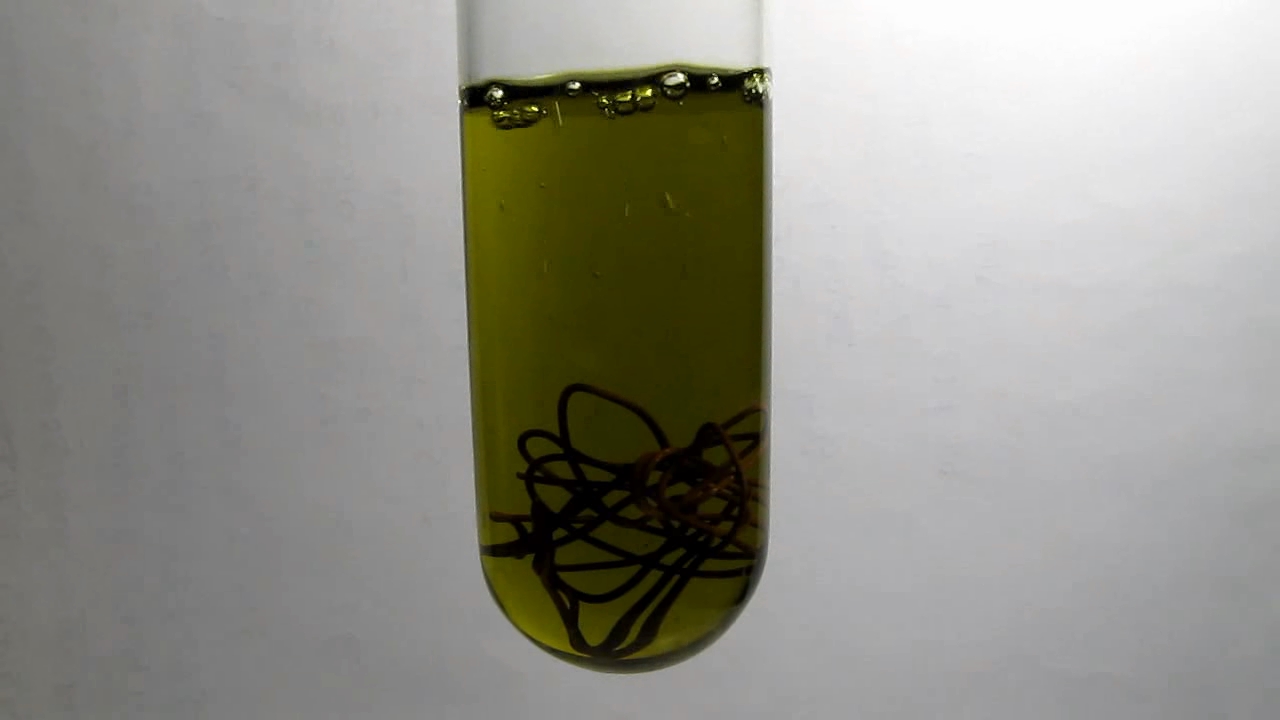
|
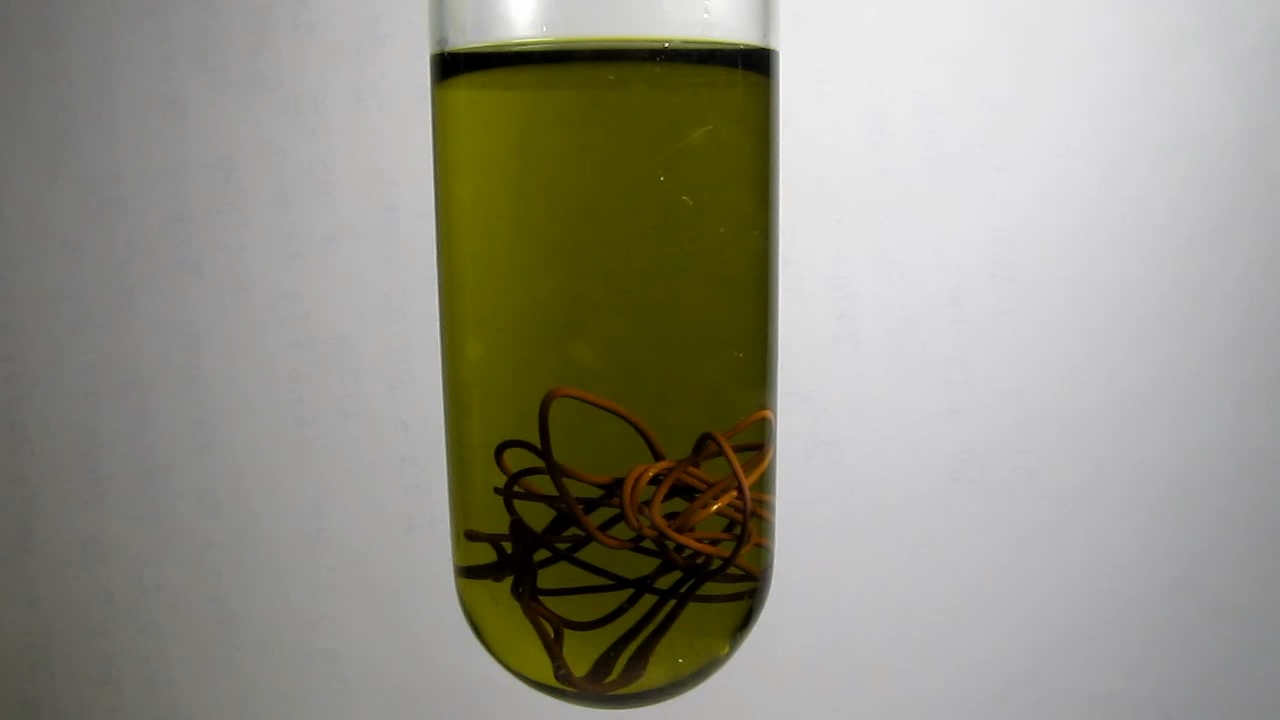
|

|

|

|
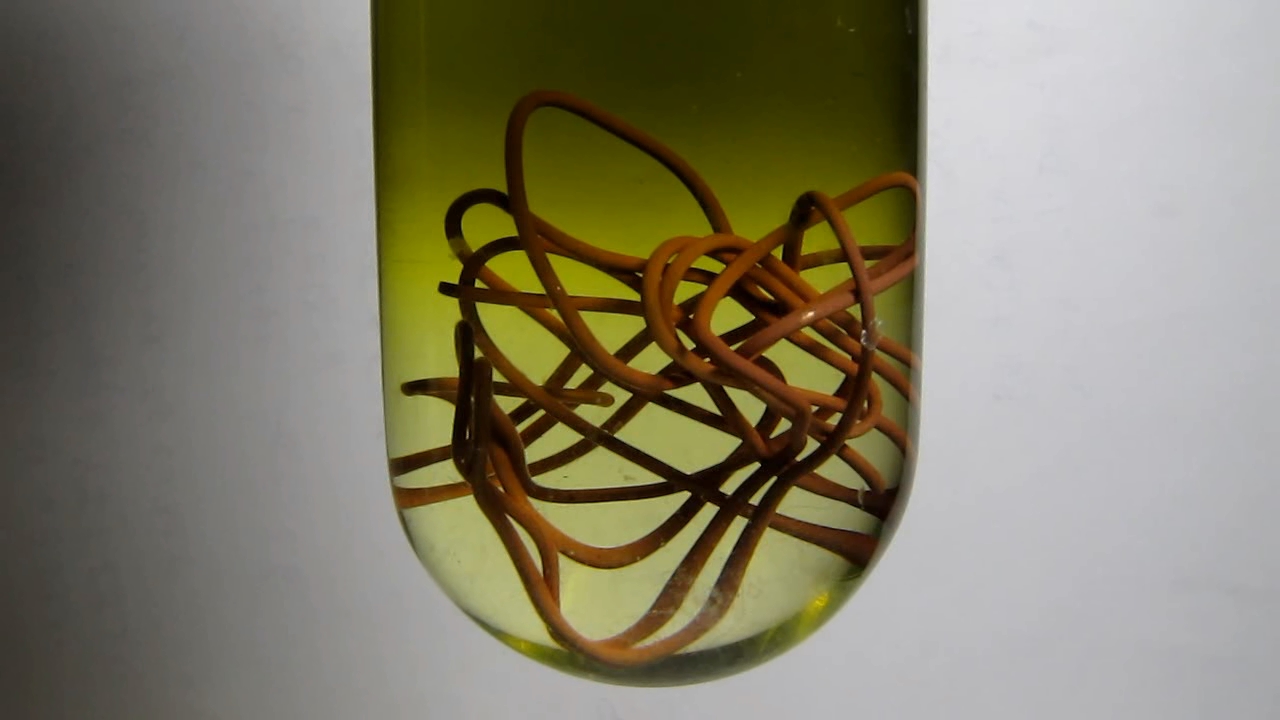
|

|
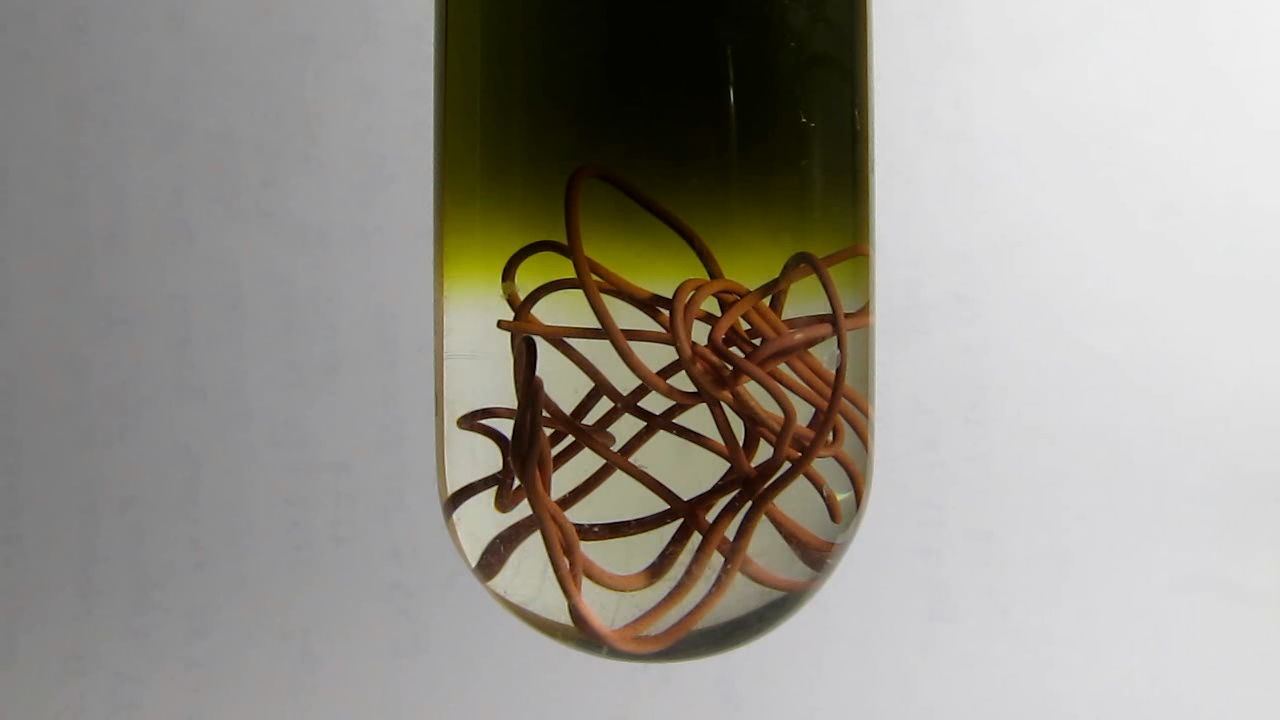
|
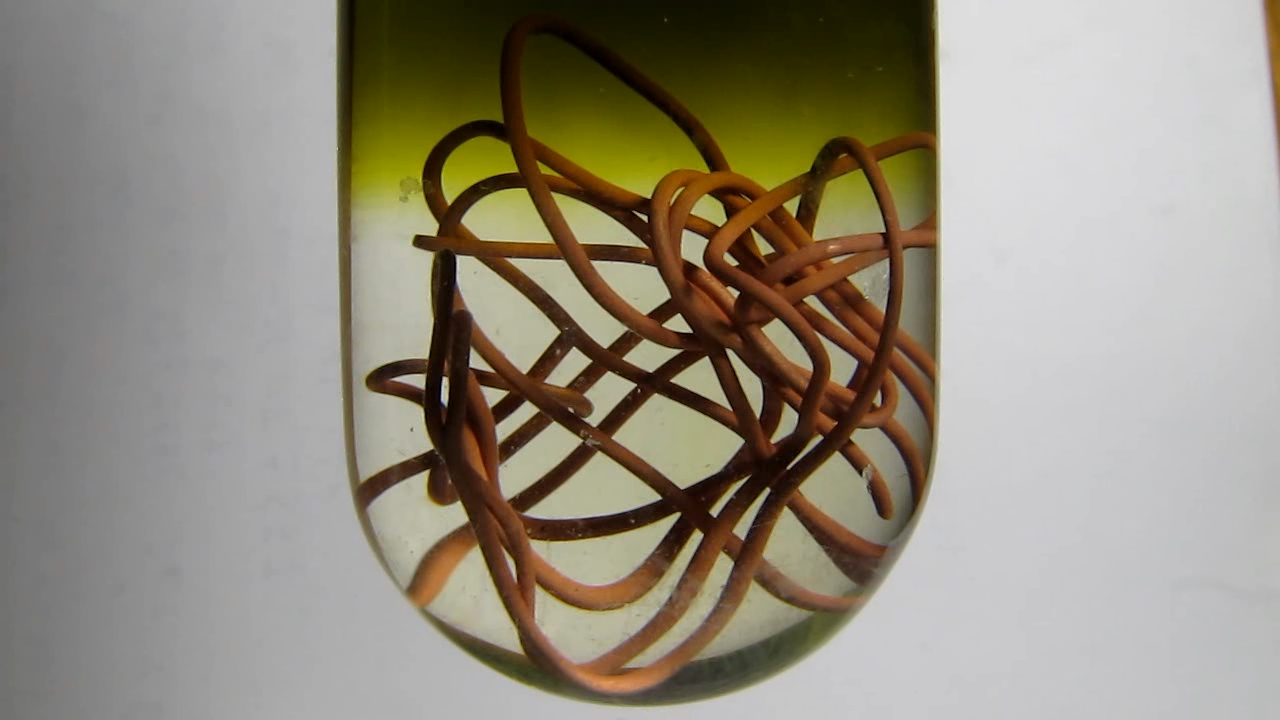
|

shaking... |

|
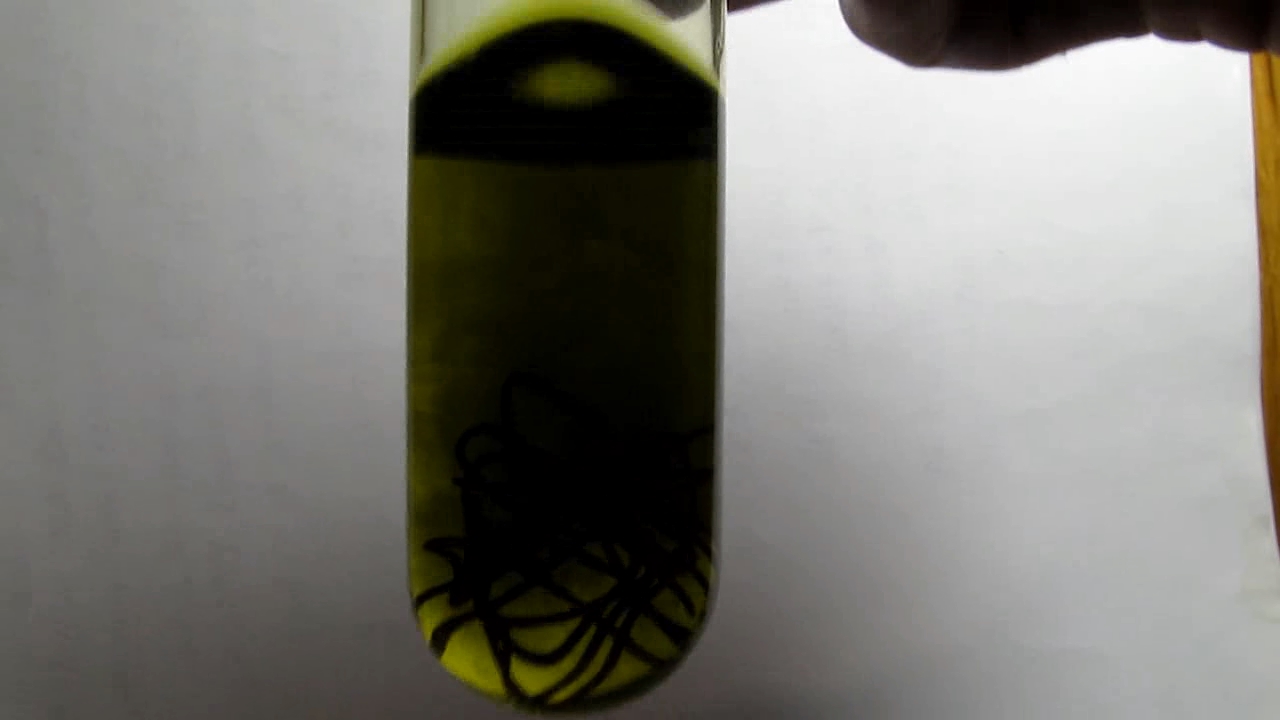
|
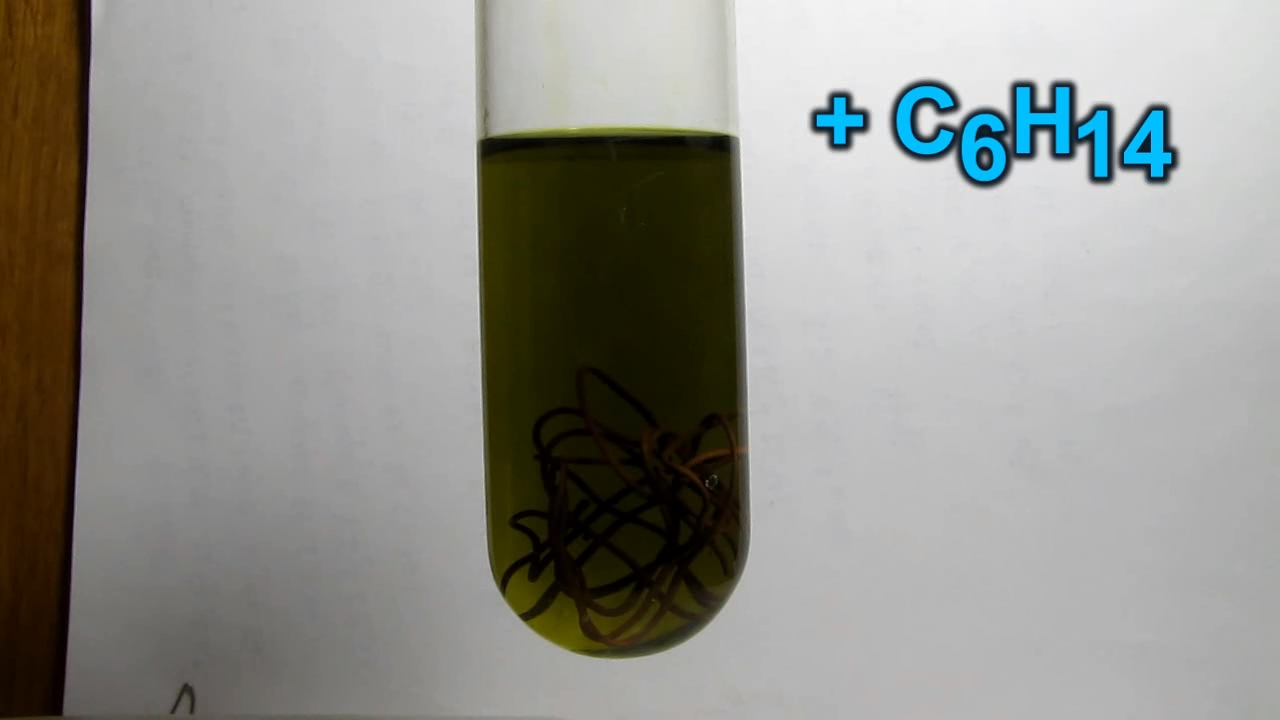
|
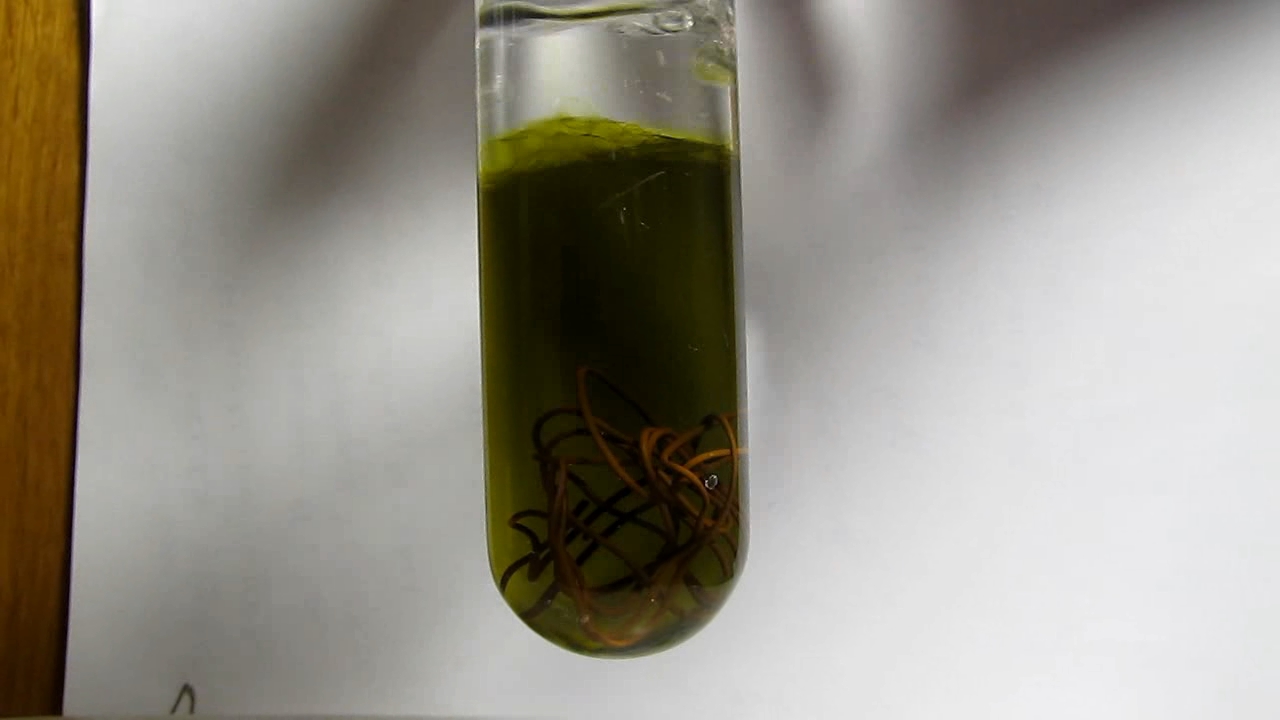
|
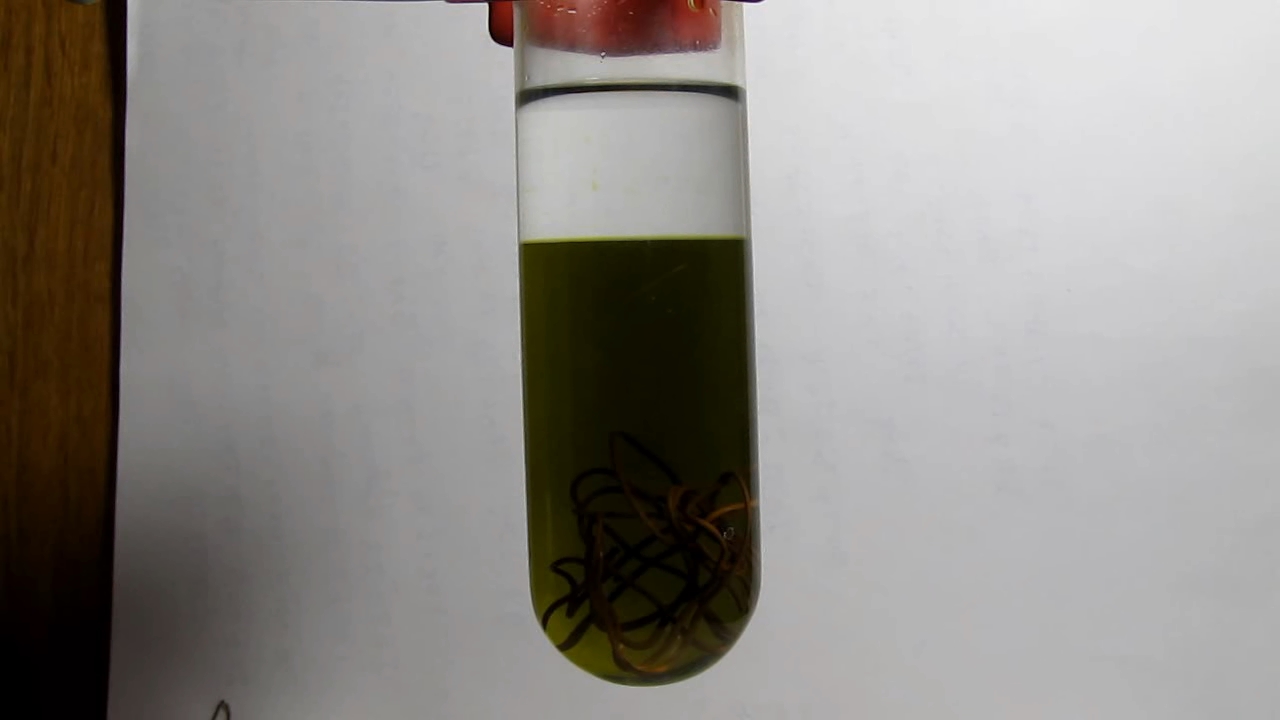
|
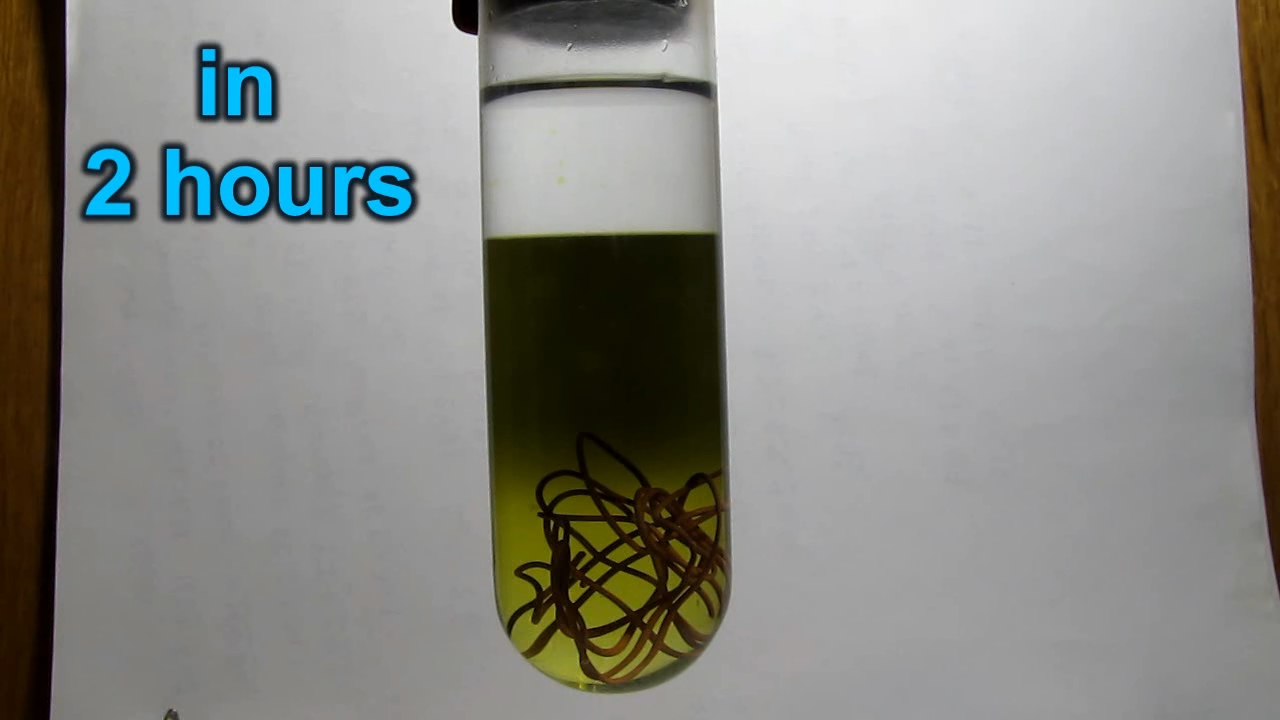
|

|

|
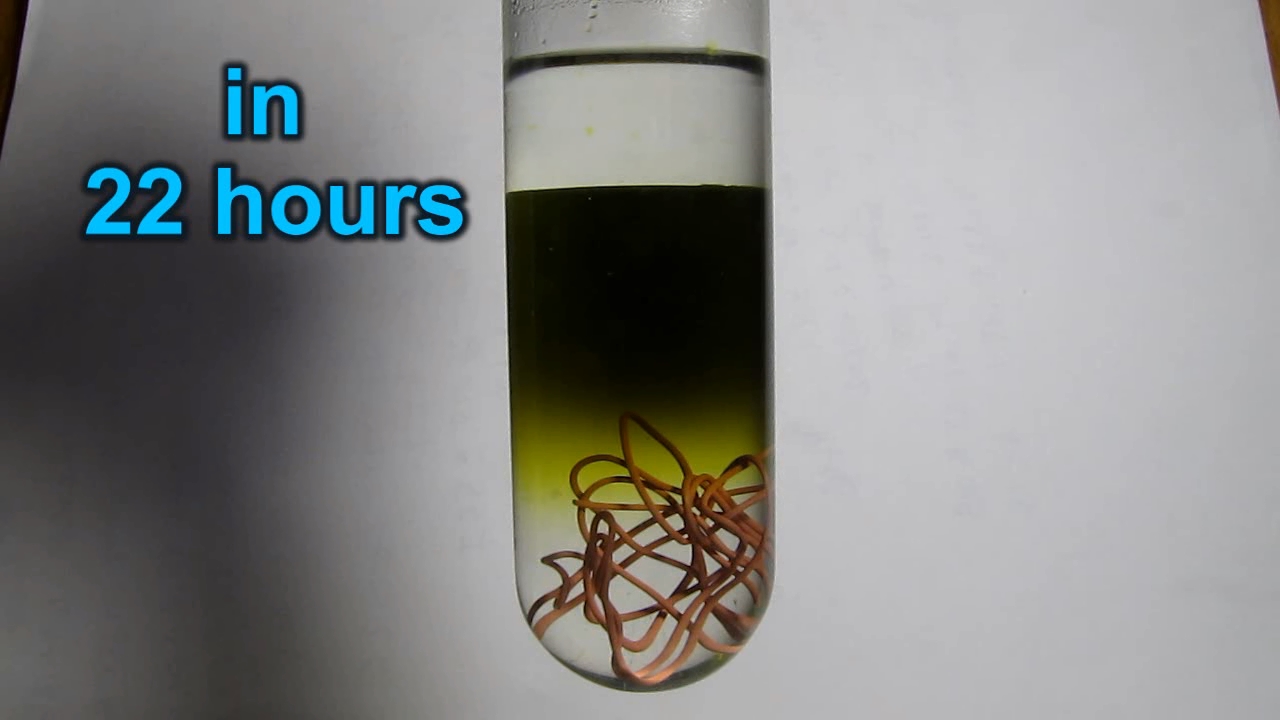
|

|
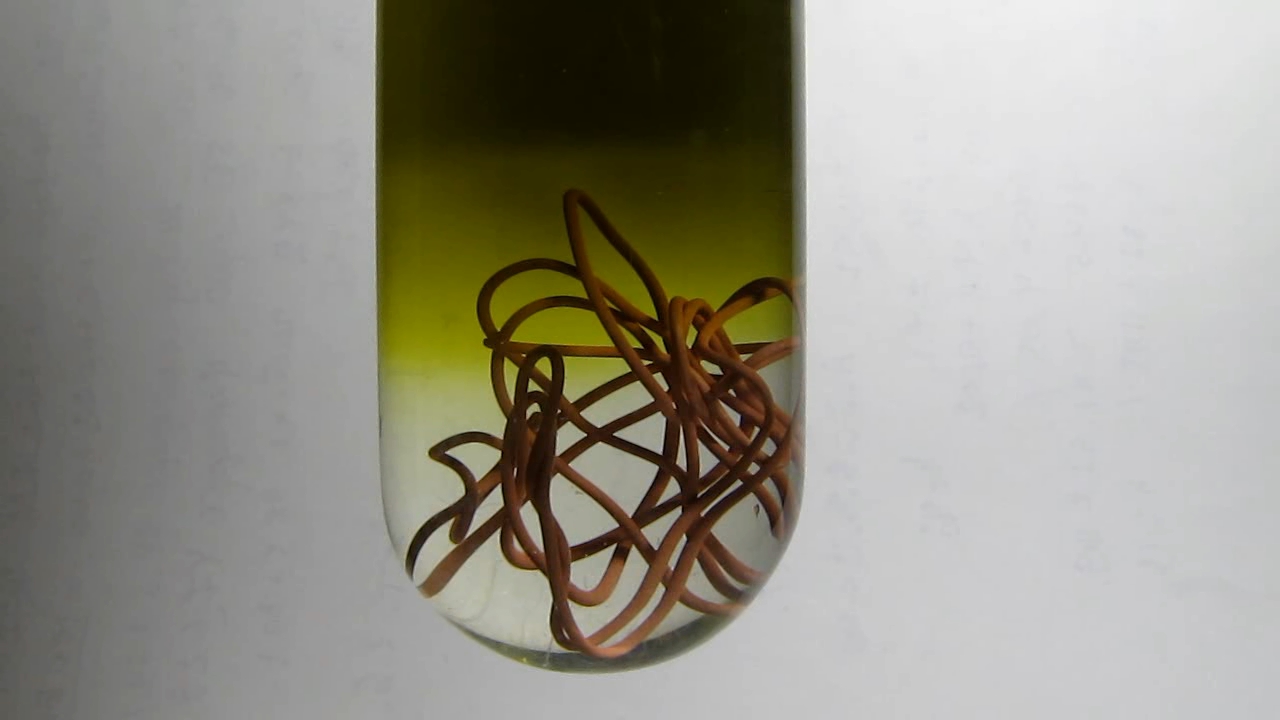
|